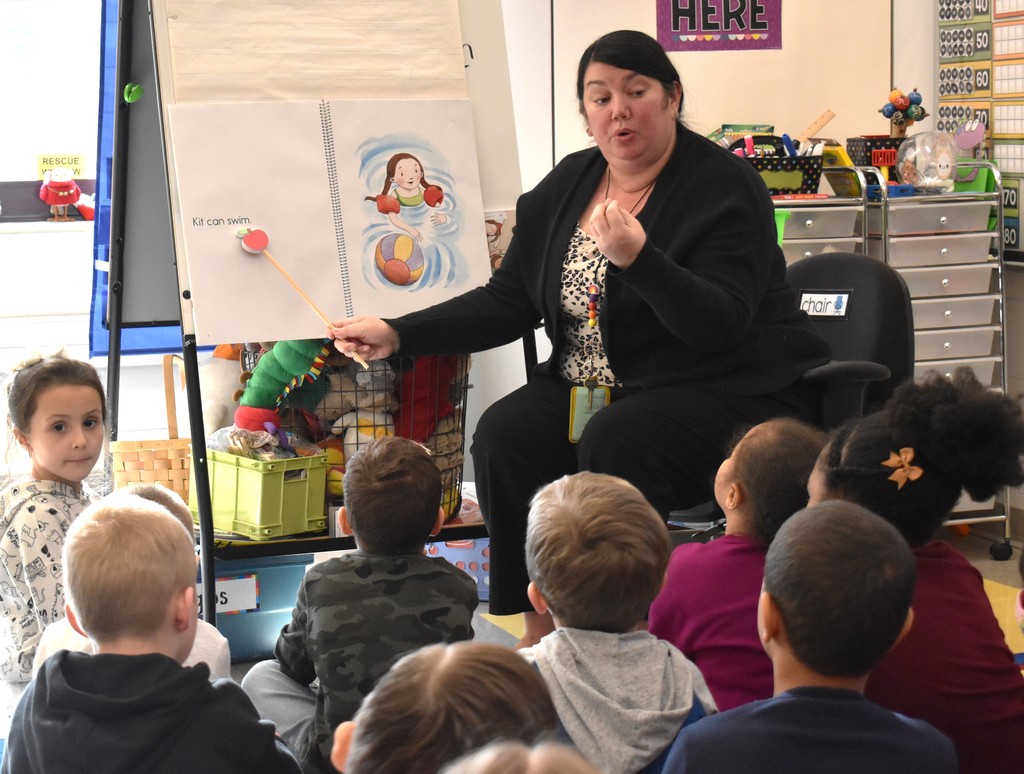The Boys Varsity Basketball Team honored its seniors for their dedication and commitment to the team at the team's recent Senior Recognition Night!
Congratulations and best wishes to: Max Earl, Nashaun Green, Angel Rodriguez, Nick Hughes, Jeremiah Phanor, Ian Tanous, Nik Marrero, Jaiden Calcano and Dominic Marasco!

TYING REAL LIFE ADVENTURES CLASSROOM LEARNING
District fourth-graders, like Emma Grunenberg’s IS fourth-graders, are beginning their new CKLA unit about geology.
To introduce her students to this topic. Ms. Grunenberg shared photos of her recent trip to Iceland, where she had a chance to visit an Icelandic tectonic plate called “Bridge Between Continents.” This bridge connects the North American plate and the Eurasian Plate! Not too many people get to visit and stand in the middle of a tectonic plate’s cracks, but Ms. Grunenberg did!
After looking at the photos, students began their first read of chapter one using the CLOZE reading strategy.
•The Bridge between Continents (or Miðlína) is a 50-foot footbridge in the Reykjanes Peninsula spanning a gaping rift between the Eurasian and North American tectonic plates. It allows people to walk from North American to Europe in a matter of seconds! The lava-scarred Reykjanes Peninsula lies directly on the Mid Atlantic Ridge. These major tectonic plates drift apart by the Earth’s forces, a few centimeters each year.
•Tectonic plates are large, solid slabs of rock that make up the Earth's crust and move slowly on top of the mantle. The movement of these plates causes earthquakes, volcanic eruptions and the formation of mountains.
•CLOZE reading is a teaching strategy that involves removing words from a passage and having students fill them in using context clues. It's used to help students learn vocabulary, grammar, and reading comprehension.
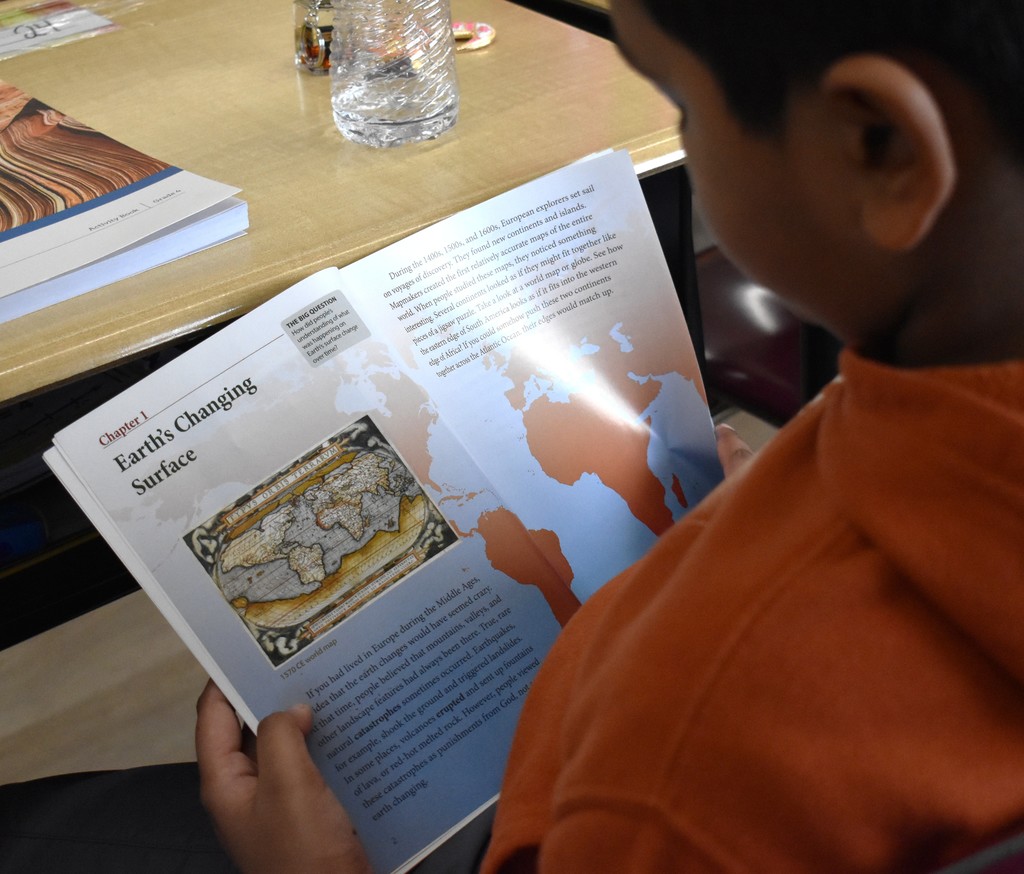


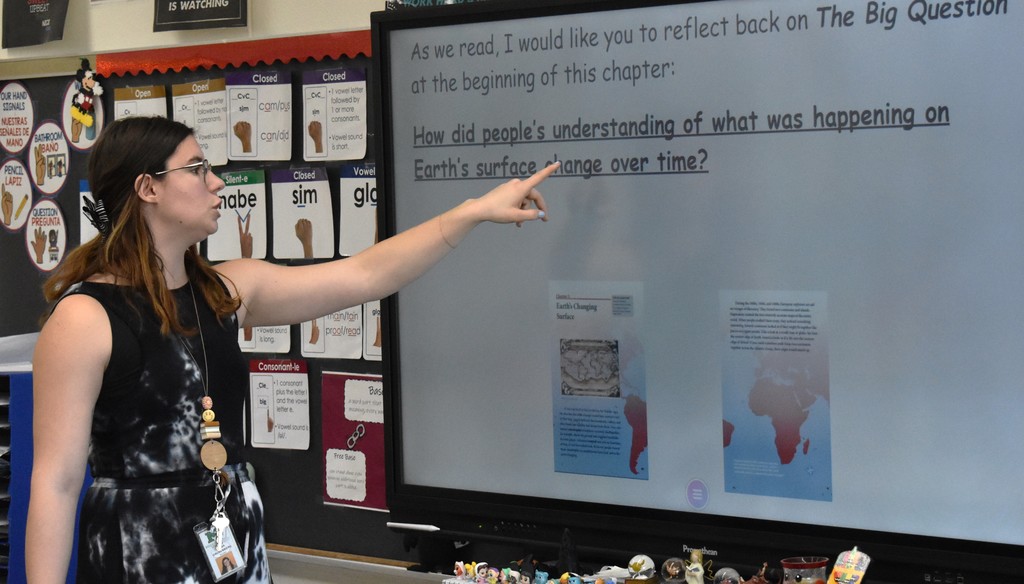
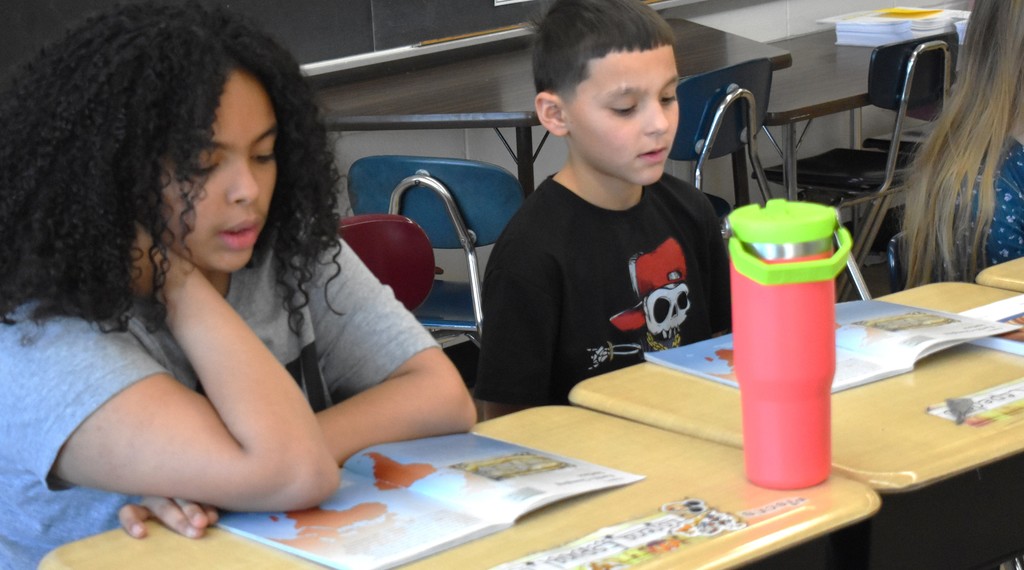
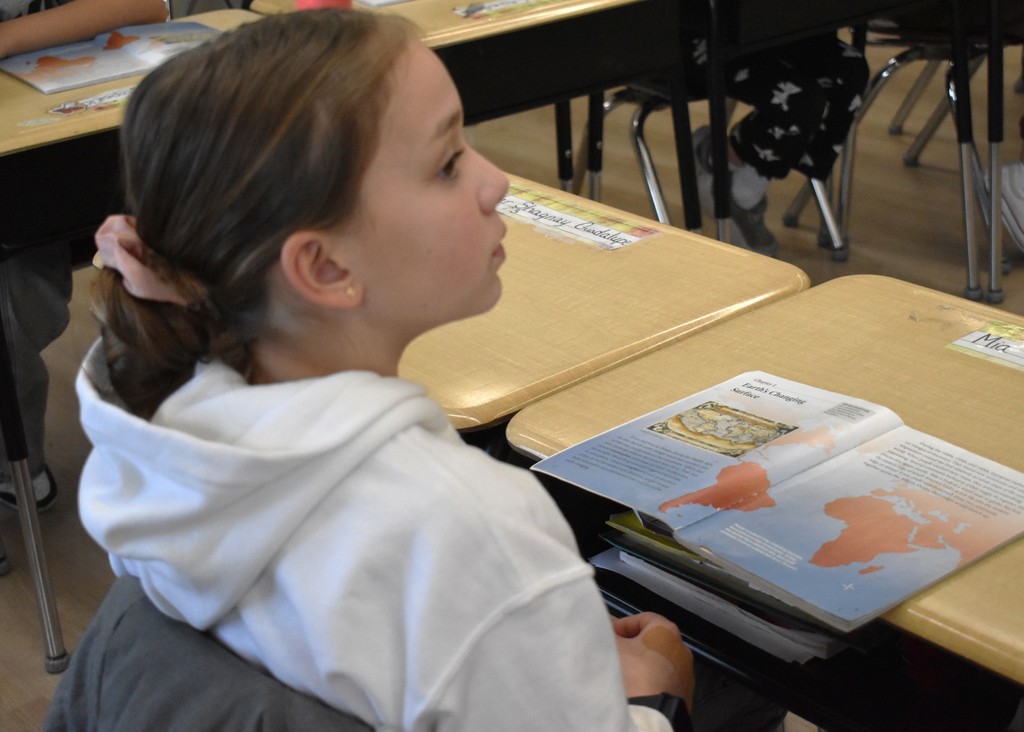
Take a peek at the recent ES Scholastic Book Fair! We bet a lot of students have some great books to read at home! Thank you to the ES PTO for organizing and overseeing this wonderful event!
Book fairs are a fun and engaging way to introduce young children to a wide variety of books, allowing them to choose titles that spark their interest, which can foster a lifelong love of reading while giving them the power to select their own books! Book fairs can help build excitement around reading within the classroom and at home, encouraging family engagement with books. See more photos on the district's Facebook page: https://www.facebook.com/MinisinkValleyCSD

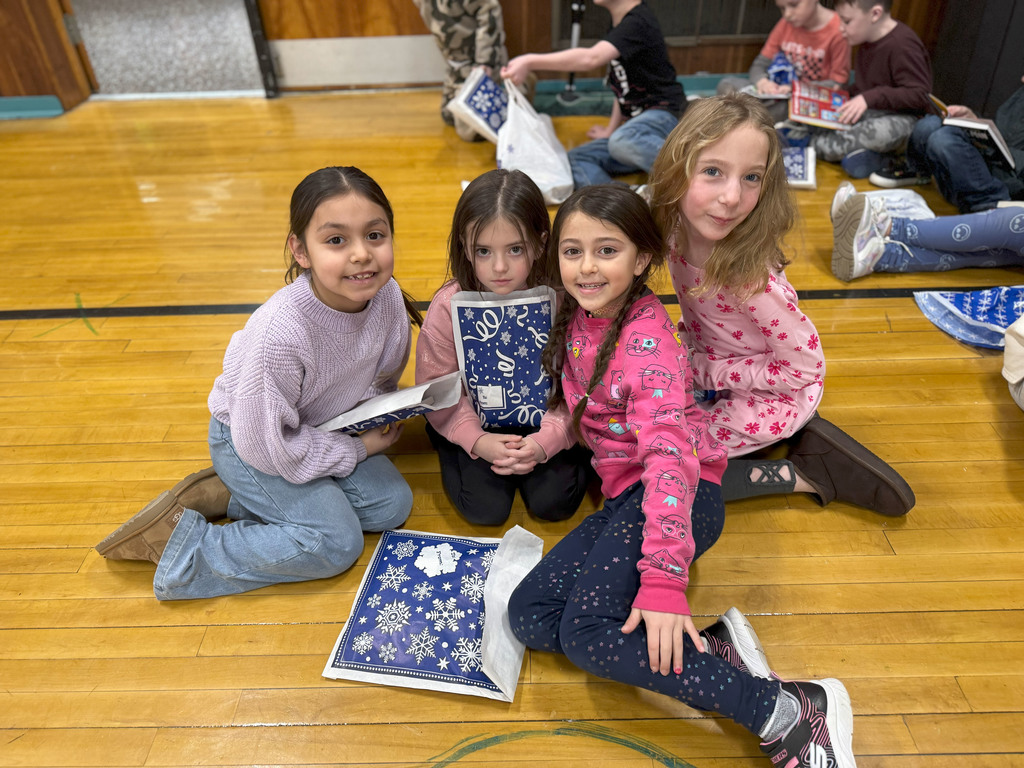


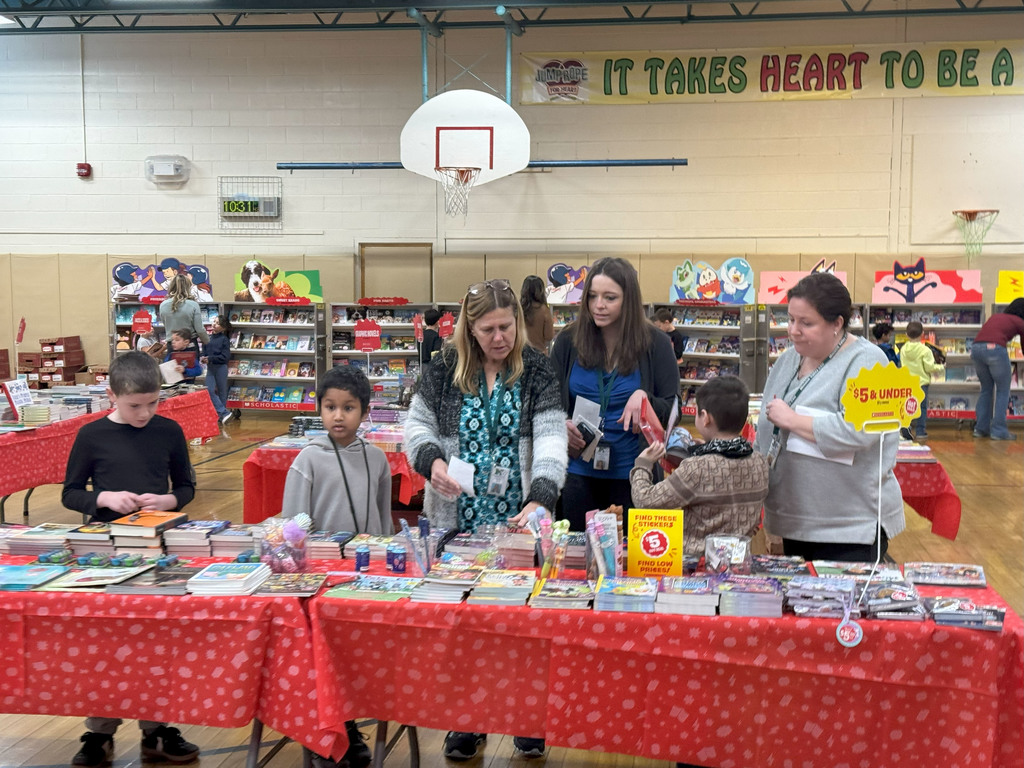


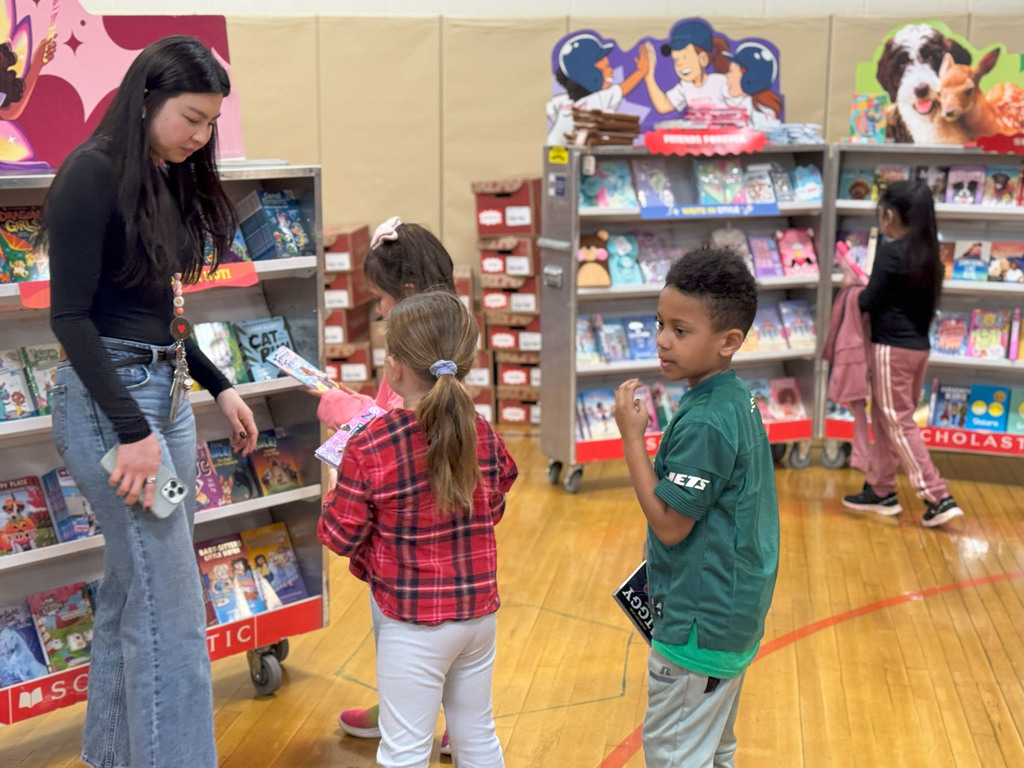
And....they're off!
Thank you to everyone who took part in this afternoon’s CLAP OUT to wish our eight wrestlers competing in the inaugural NYSPHSAA Girls Wrestling Championship good luck, best wishes and much success at tomorrow’s tournament!
You got this, ladies, and we’re thrilled you’re representing Minisink Valley in this first-ever girls wrestling championship tournament! We're rooting for you! Please share your good wishes below!





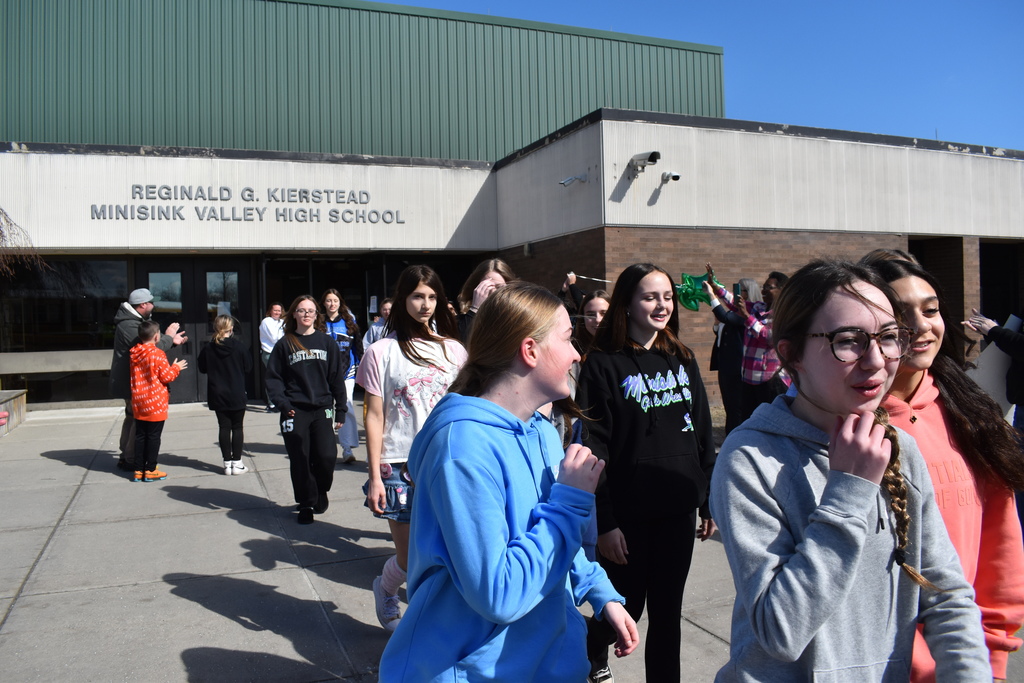
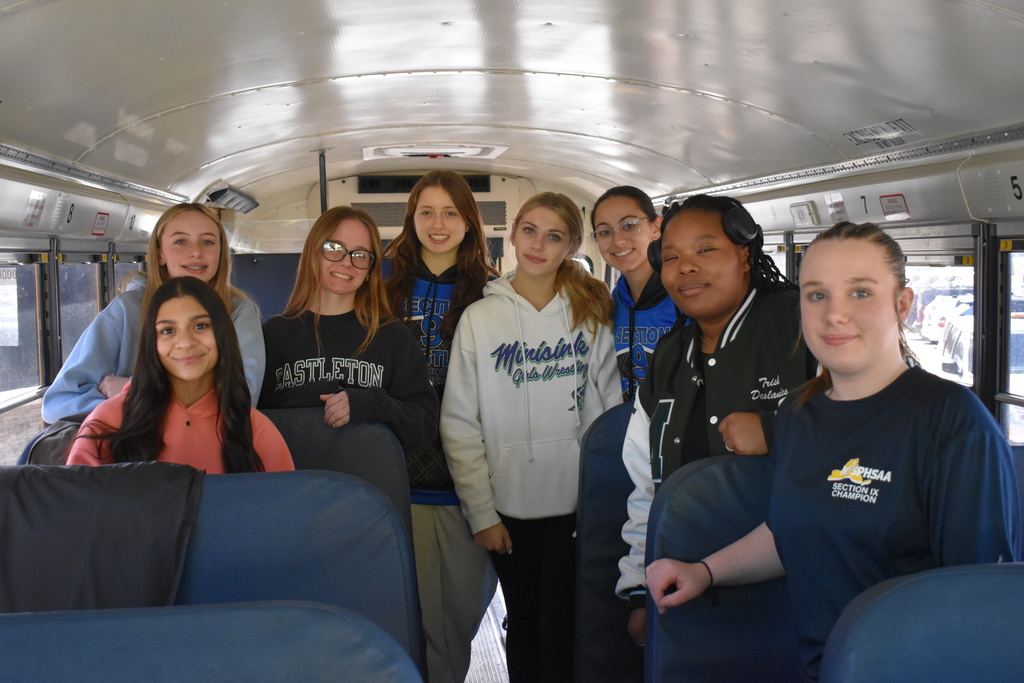
Jessica Kahn’s Otisville kindergarteners recently learned about comparing the capacity of containers by counting and recording the numbers of scoops of blue liquid required to fill each one.
Since they couldn't “see” the scoops once they were poured into the containers, they needed to use the numbers to see which one held more. The students practiced using the terms, “greater than” and “less than” when comparing the numerals (so, 16 is greater than 2 and 2 is less than 10).
Learning "greater than" and "less than" in kindergarten is crucial because it lays the foundation for understanding number relationships, which is a fundamental math skill that allows children to compare quantities, build a strong base for future math concepts like addition and subtraction, and helps them grasp the concept of relative size and value, all while developing important critical thinking skills.
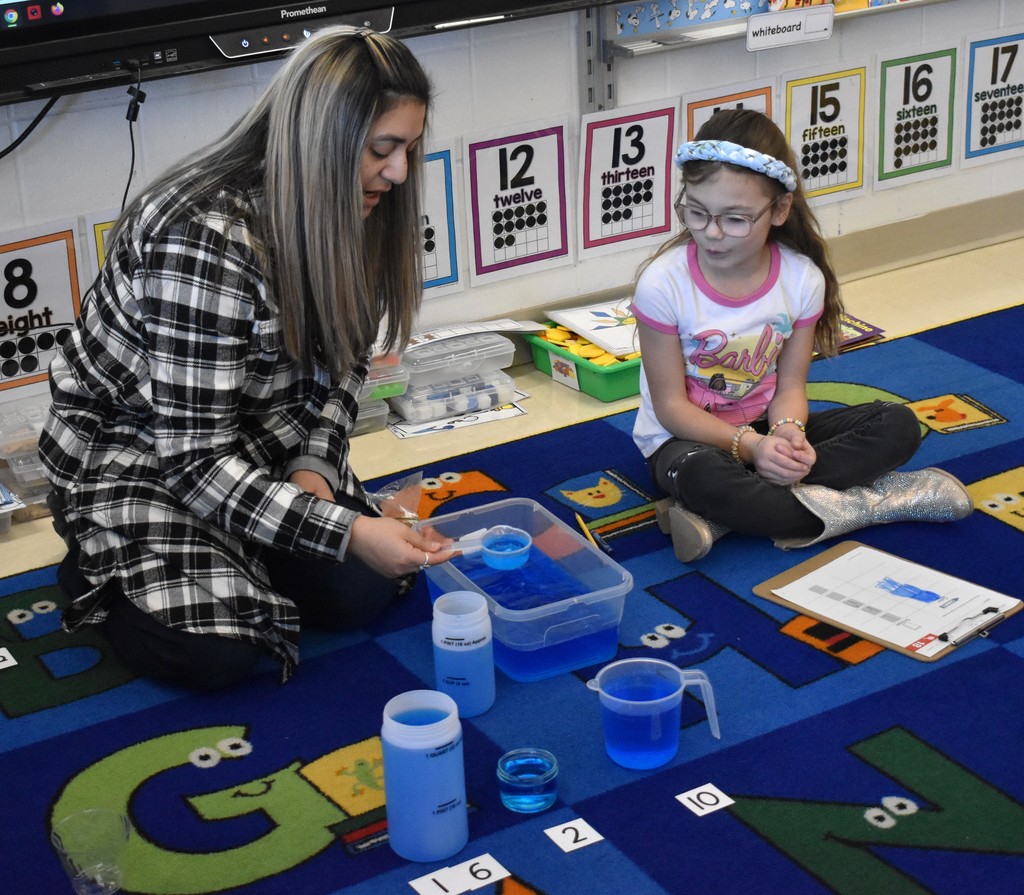
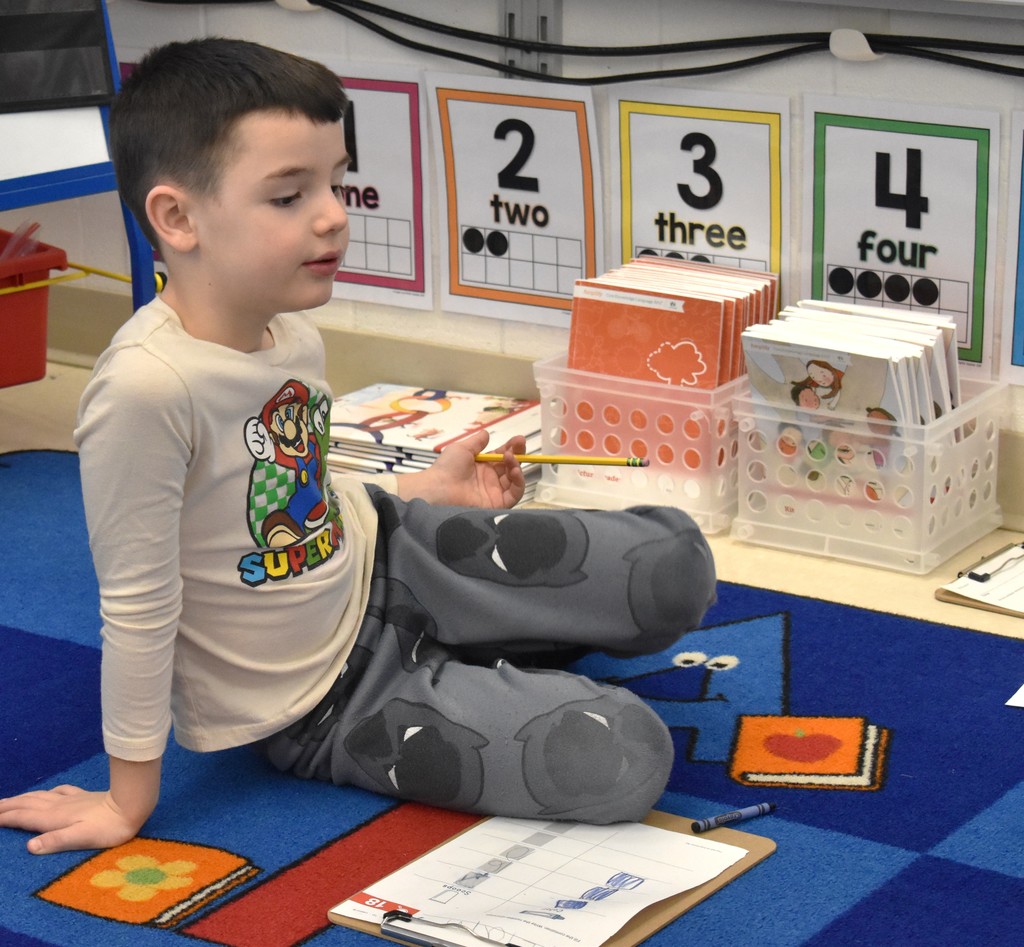
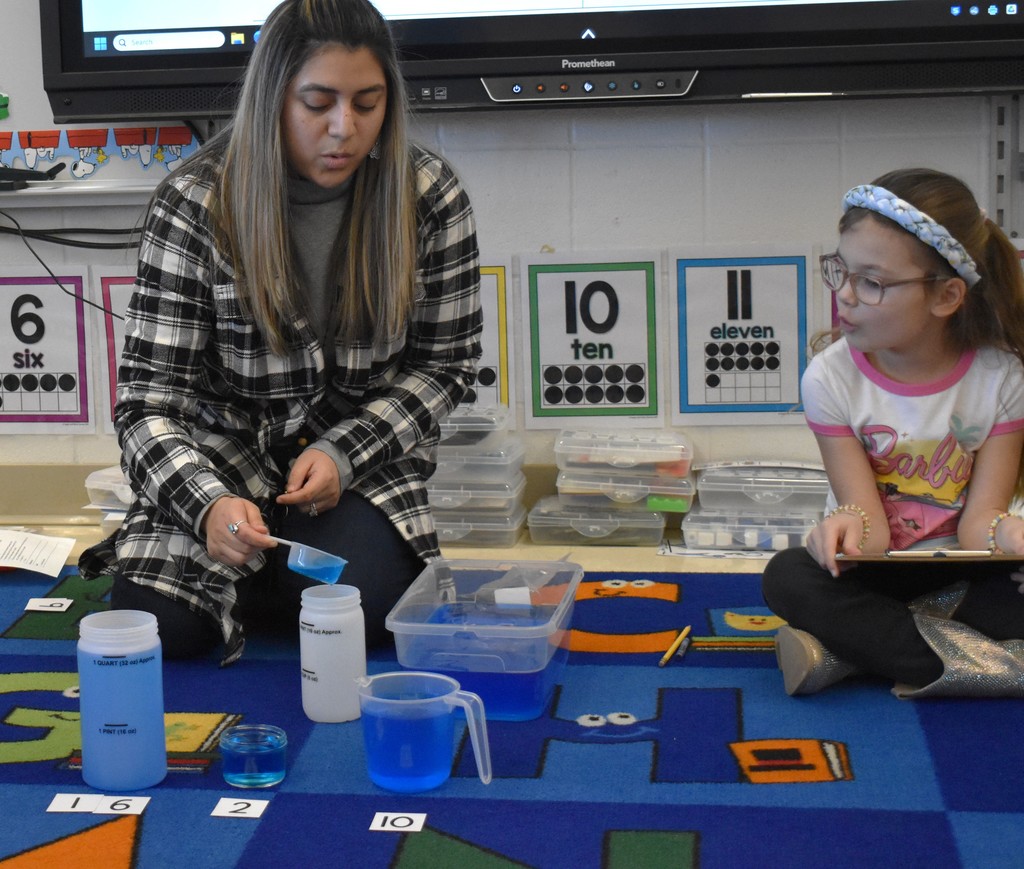


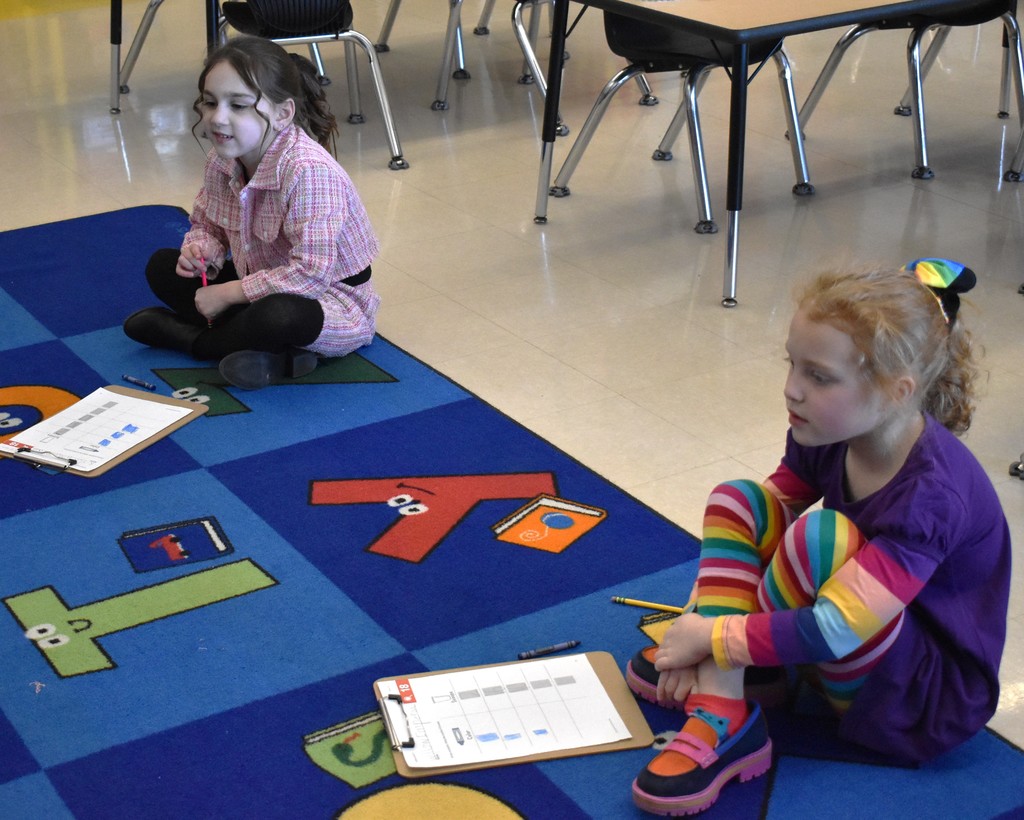
Kara Welsh’s Otisville fourth-grade art students a
re mastering the concepts of foreground, midground and background in their artwork!
In this recent assignment, students were tasked with creating a piece of art that represents their understanding of these elements. Take a peek at their creative work!
In elementary art class, students learn about foreground, midground, and background to understand and create the illusion of depth in their artwork, by visually representing how objects appear larger and more detailed when closer to the viewer (foreground), and smaller and less detailed as they get further away (background), allowing for a more realistic composition in their drawings and paintings.
In addition to learning more about creating depth, understanding object size and detail and compositional structure, students are also seeing a real life ponent to their work: Objects appear larger when they are close and smaller when they are far away.
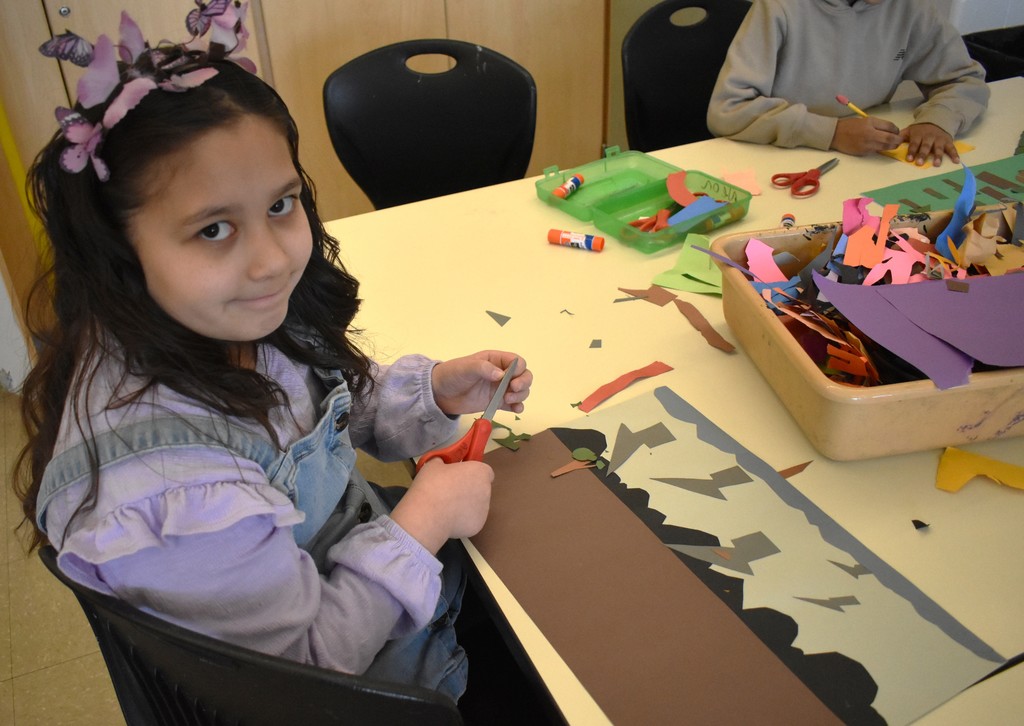
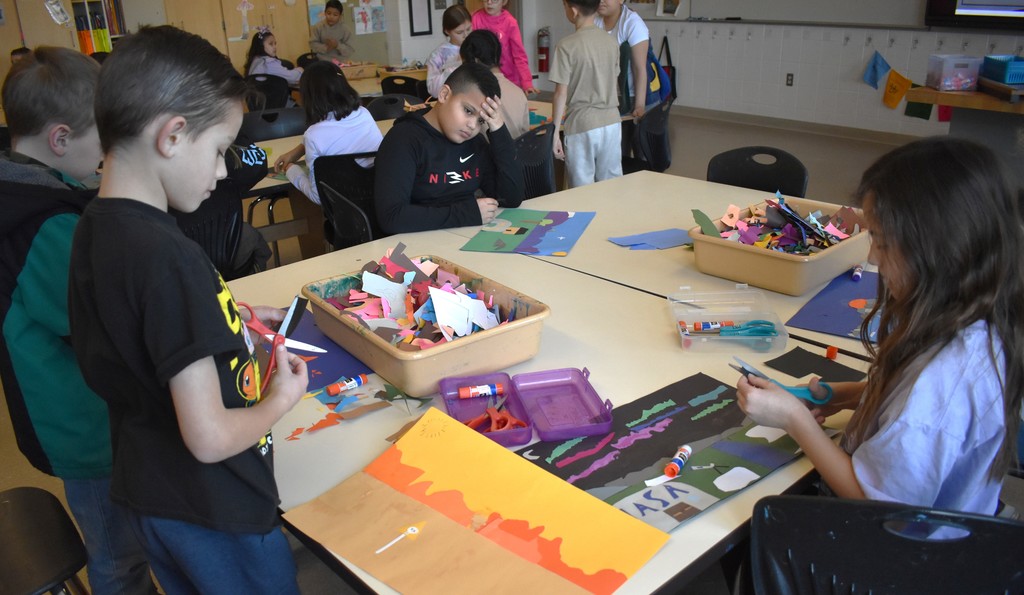



The cast and crew of the Otisville Elementary Drama Club are busy putting final touches on their March 4 and 5 productions of WILLY WONKA KIDS! Take a peek!
Remember, admission is free for everyone! Don't miss out!
"Willy Wonka KIDS" follows enigmatic candy manufacturer Willy Wonka as he stages a contest by hiding golden tickets in five of his scrumptious candy bars. Whomever comes up with these tickets will win a free tour of the Wonka factory, as well as a lifetime supply of candy.
Four of the five winning children are insufferable brats, but the fifth is a likeable young lad named Charlie Bucket, who takes the tour in the company of his equally amiable grandfather. The children must learn to follow Mr. Wonka's rules in the factory — or suffer the consequences!


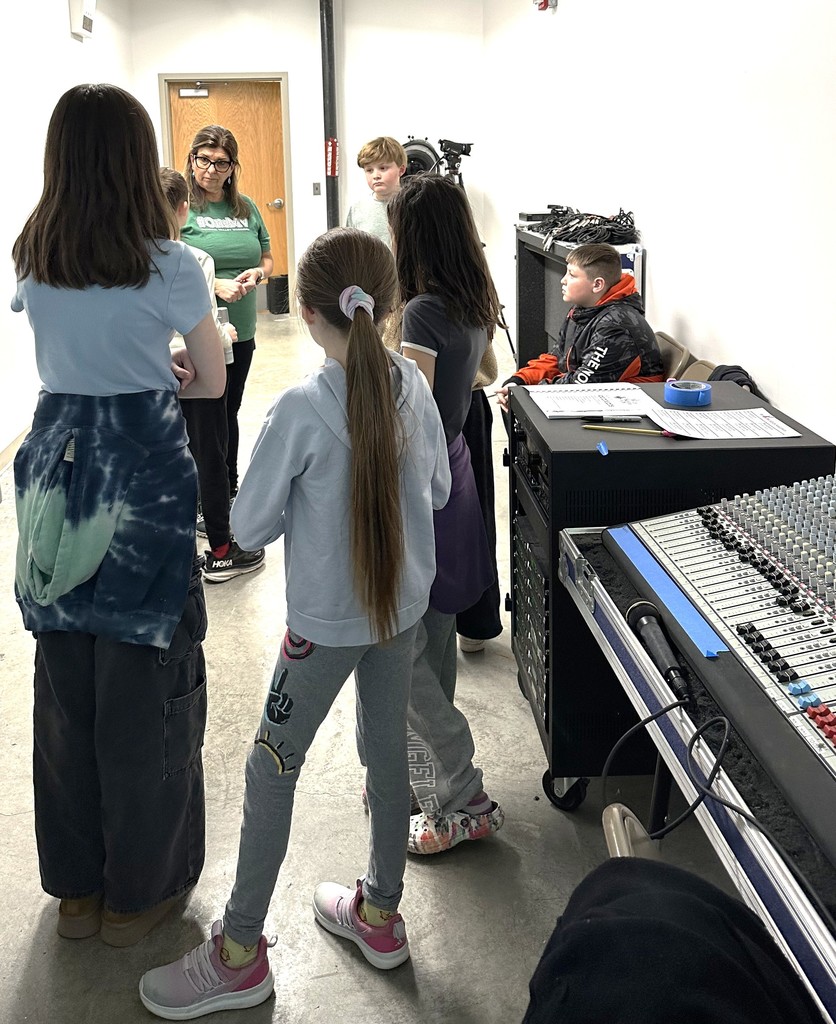

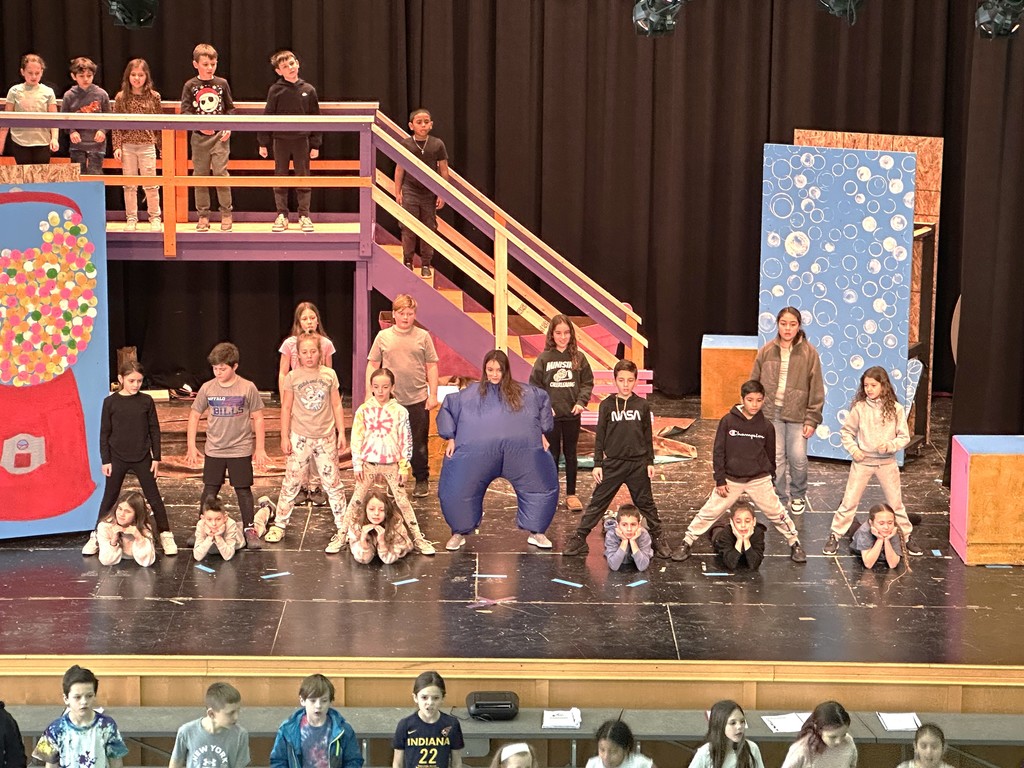


Bailey Riley’s seventh-grade science students, like their peers, are learning about kinetic and potential energy. As part of their studies, students recently completed a lab where they were tasked with observing different factors that affect amounts of energy.
What better way to do this than with tennis, golf and ping pong balls? Students “dropped” these three balls at different heights and observed how much they each bounced. The balls which bounced the most had the most energy.
Studying kinetic and potential energy in seventh-grade science is important because it provides a foundational understanding of how energy exists in different forms, how it can be transferred between objects, and how this concept applies to everyday situations, laying the groundwork for further exploration of more complex physics concepts later on. It helps students grasp the basic idea of energy in motion (kinetic) and stored energy (potential) which are crucial for understanding many natural phenomena around them.
• Kinetic energy is the energy of motion, meaning it's the energy an object has due to its movement
• Potential energy is stored energy that an object has due to its position or arrangement, ready to be released as kinetic energy when conditions change

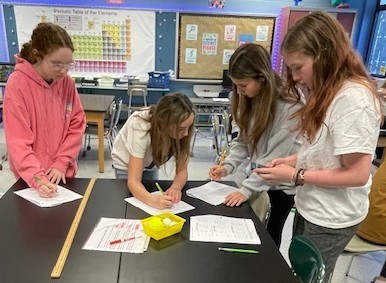

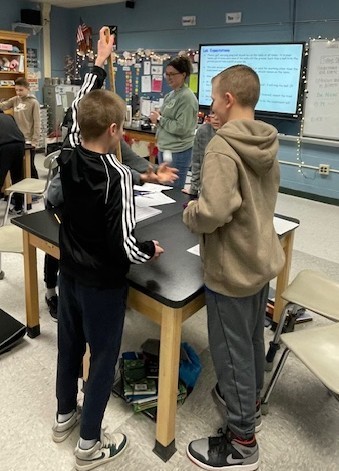

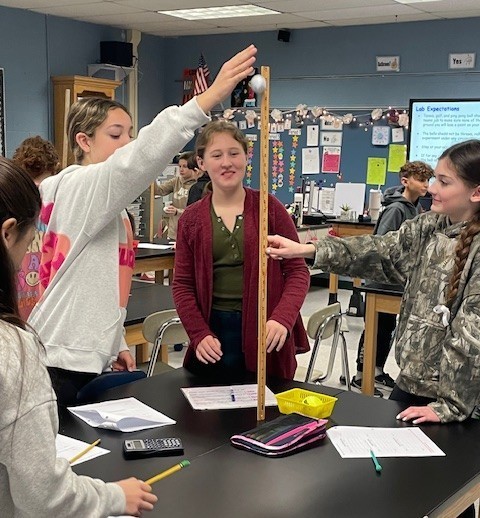
Congratulations and best wishes to members of the senior members of the Varsity Cheer team, who were honored and recognized for their many contributions to the team’s success during their recent Senior Night and Cheer Showcase: Jillian Babcock, Natalie Christiano, Sara Delmar, Cara Durlester, Emma Gutzeit, Kaitlyn Howell and Mia Lockowitz!
Members of the Minisink Youth Cheer program and the team showcased their routines during this gathering!

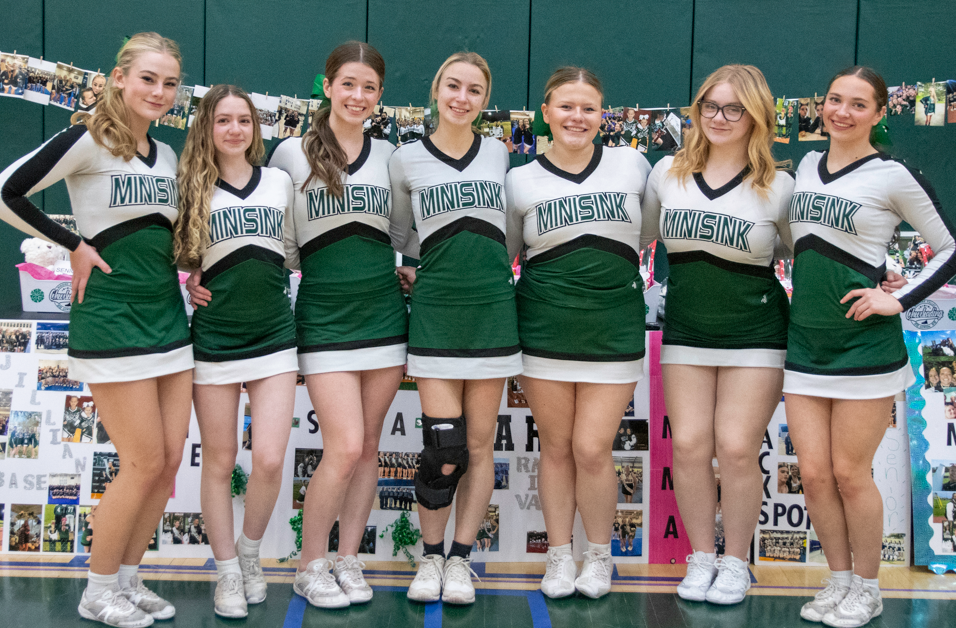


The varsity girls and boys indoor track & field programs capped their invitational season in winning style this past weekend at the Garden State Open, hosted by The Armory Track & Field Center. The teams had nine podium finishers and six event winners in their final tune-up for the Section IX State Qualifier.
Minisink Valley once again drew on the strength of its relays, sweeping the boys' and girls' 4x400 meter relays to close the meet, outdueling Section IX rivals Monroe-Woodbury in both races.
The girls quartet of Zoey Terpak, Kaleigh Murphy, Lyla LaBarbera and Ferrah Hill eased to the win in 4:07.07, good for #1 in the section this season. Not to be outdone, the boys' squad of Benjamin Spevak, Robert LaBarbera, Jon Mausling and Samuel Anderson stormed to victory in a thrilling lean at the tape, establishing a new program record and New York #2 mark of 3:21.02 in the process.
Also earning gold medals for Minisink Valley were Samuel Anderson (:48.75, 400-meter dash), Ella Michelitch (5' 6", high jump), and Delila Kronimus (11' 6") and Logan Schupner (15' 6") in the pole vault.
Tyler Cloidt (11' 6", pole vault) and the girls 4x200 team of Murphy, Chloe Beck, Terpak and Kessler Hirsch earned fifth place medals, while Michelitch nabbed the final podium position in the long jump (16' 3").
The teams now have their eyes set on advancing individual athletes and relay teams to the NYSPHSAA/Federation Championships, with the Section IX State Qualifier to be hosted by The Armory Track & Field Center on Saturday, March 1.
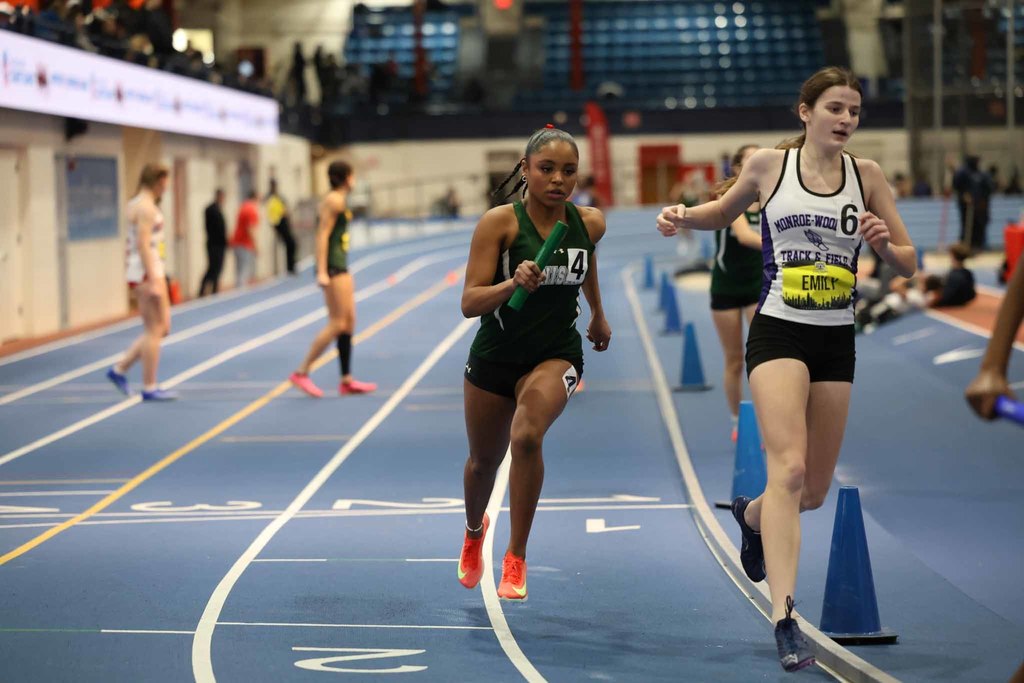
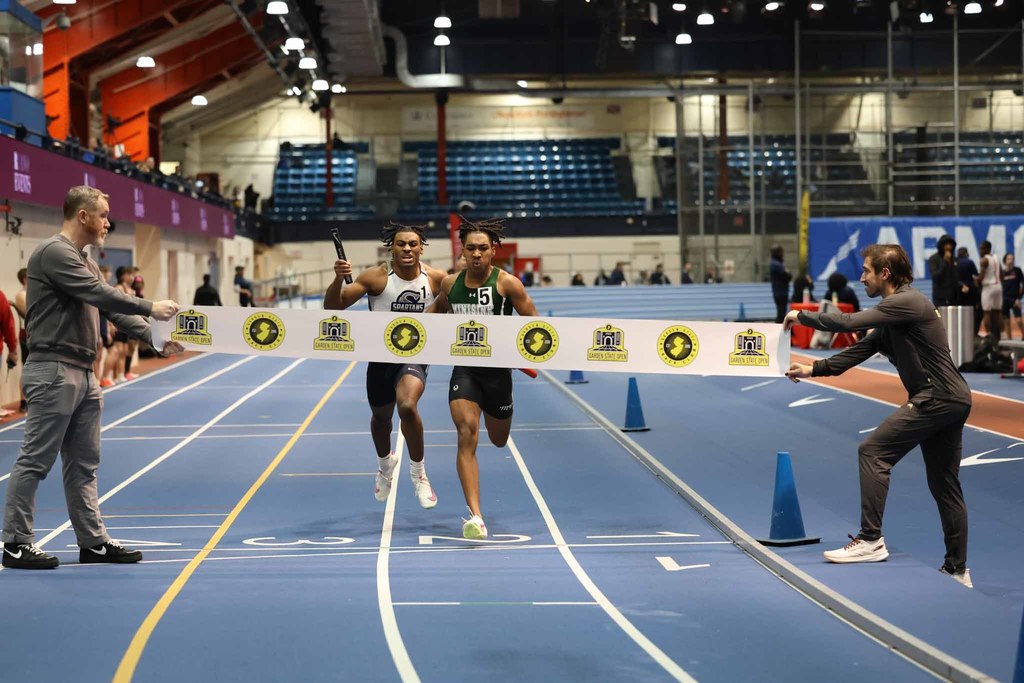
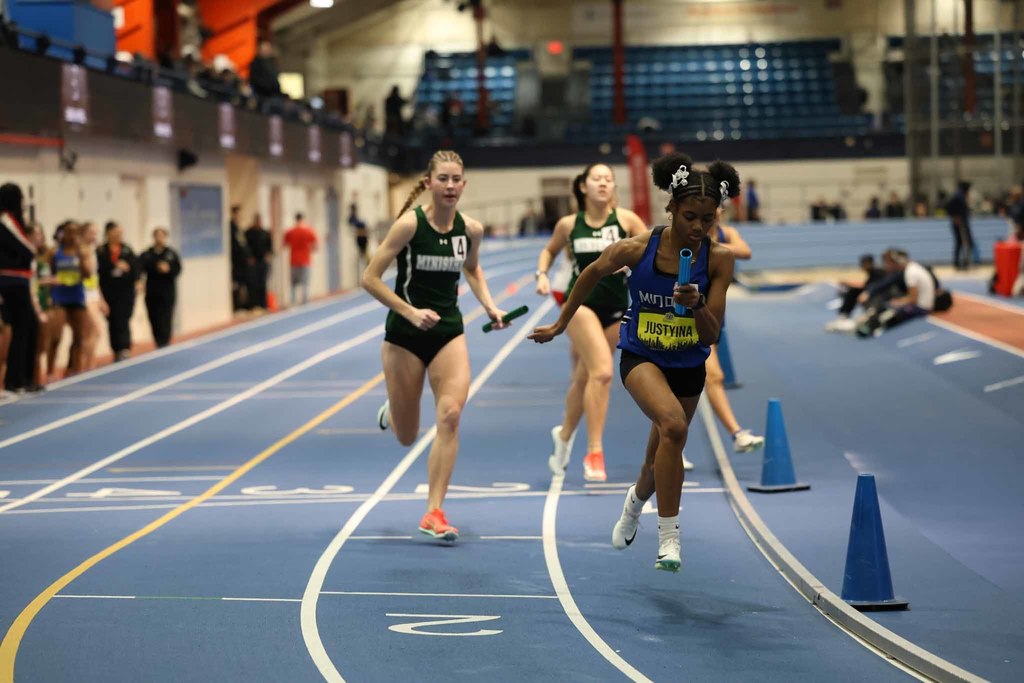
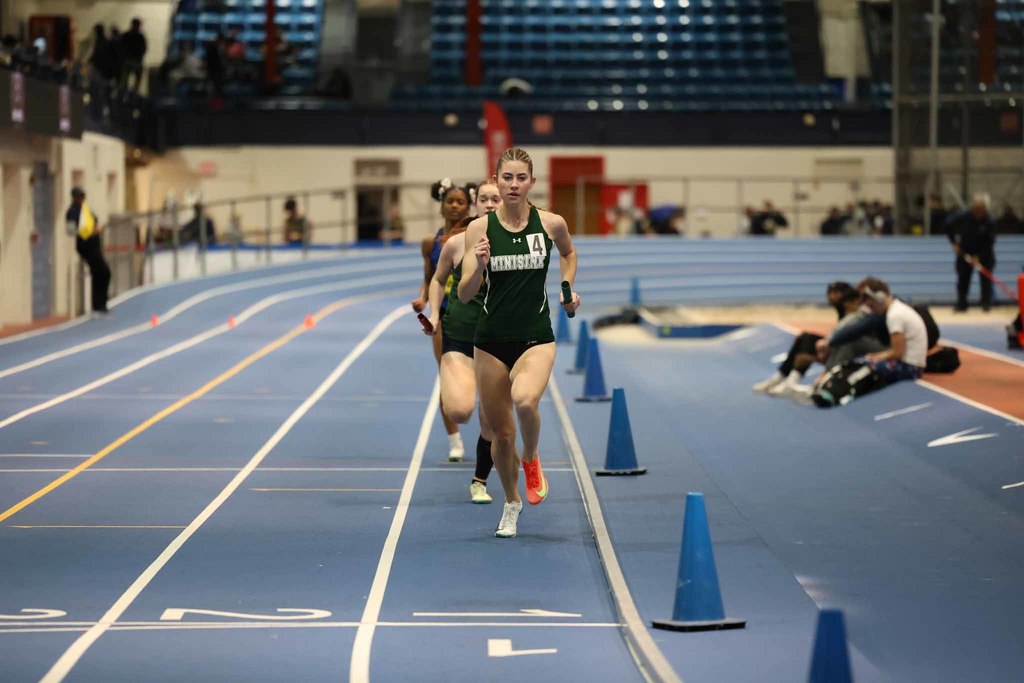
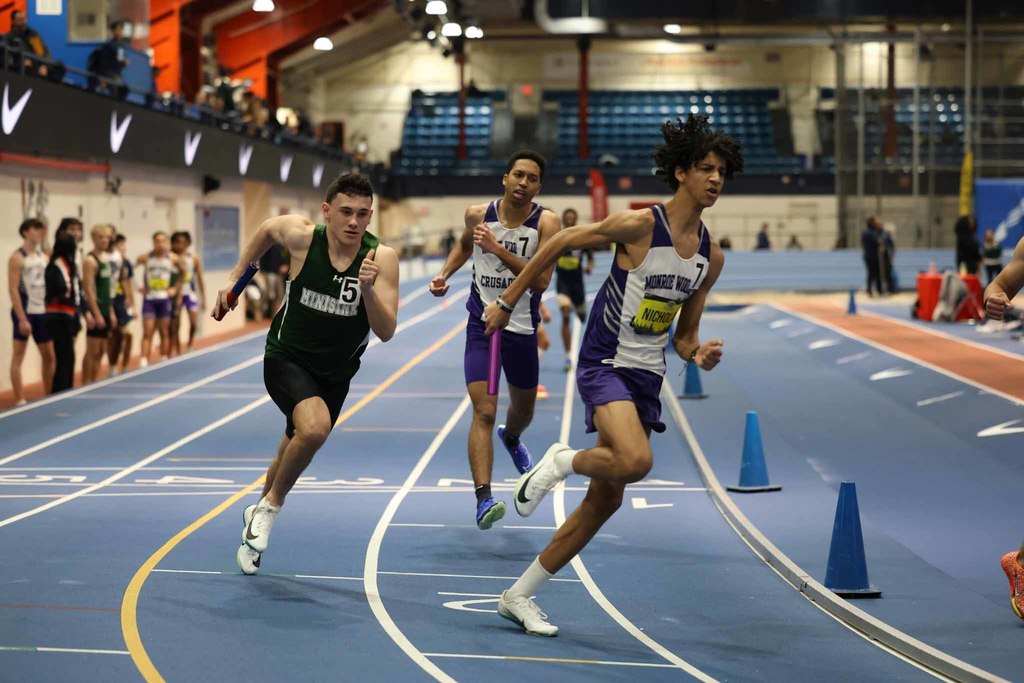
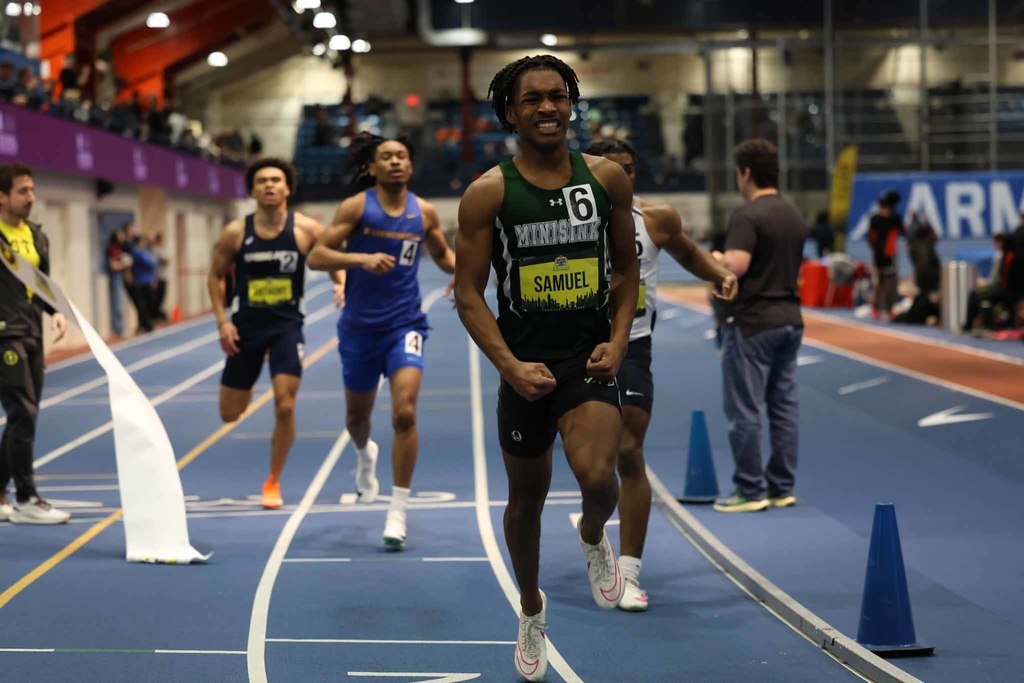
Take a peek at rehearsals of the Middle School Drama Club's production of Disney's HIGH SCHOOL MUSICAL JR.! do you have your tickets yet?
GET THEM HERE: https://www.onthestage.tickets/.../678076f055ebc03250cd5693
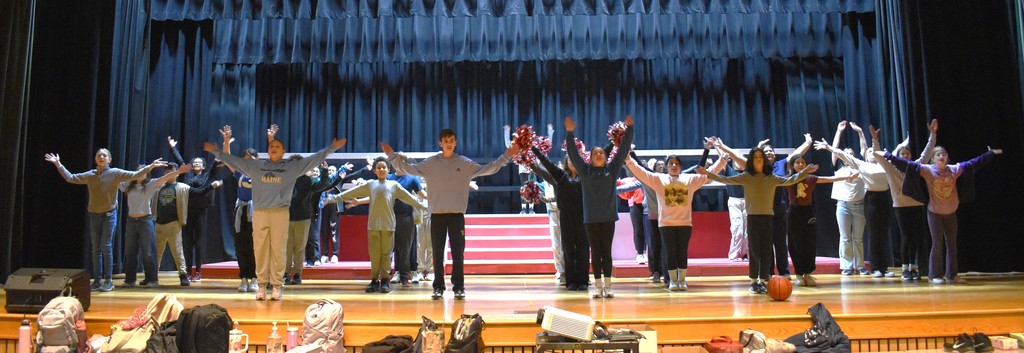

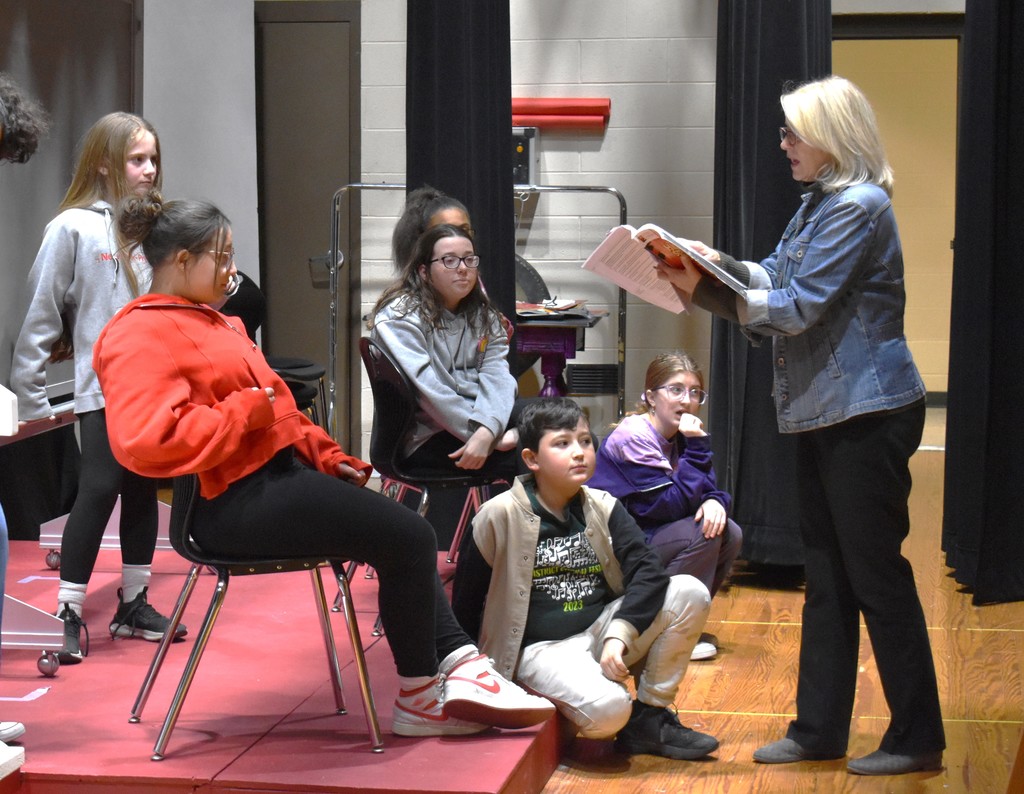
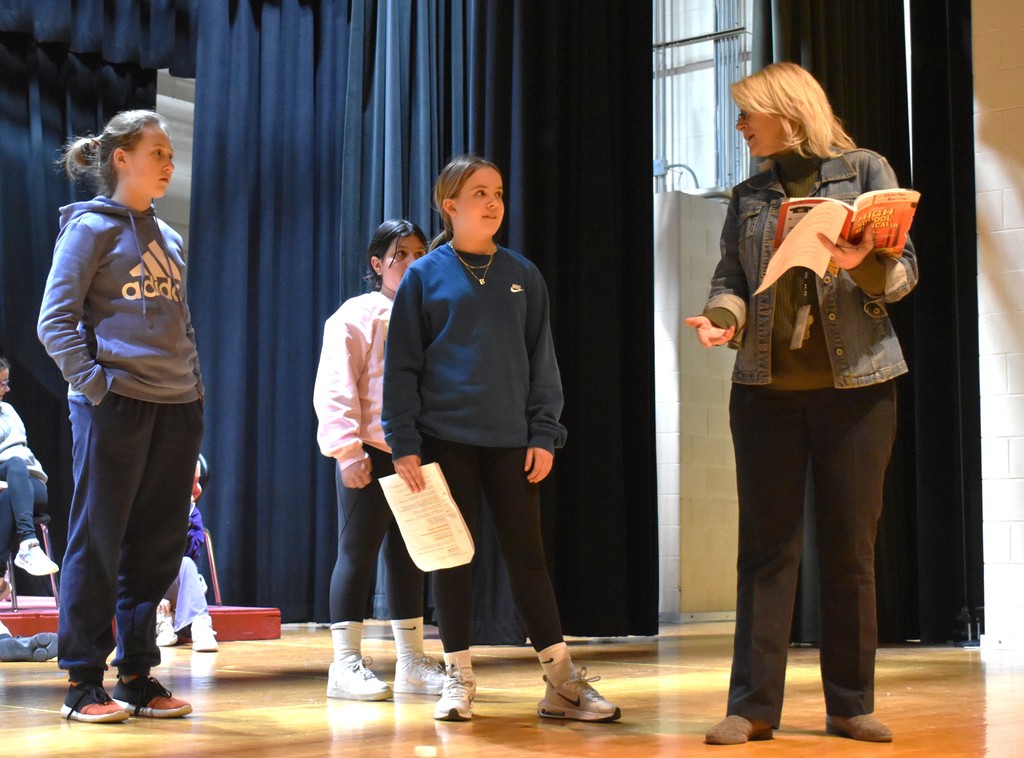

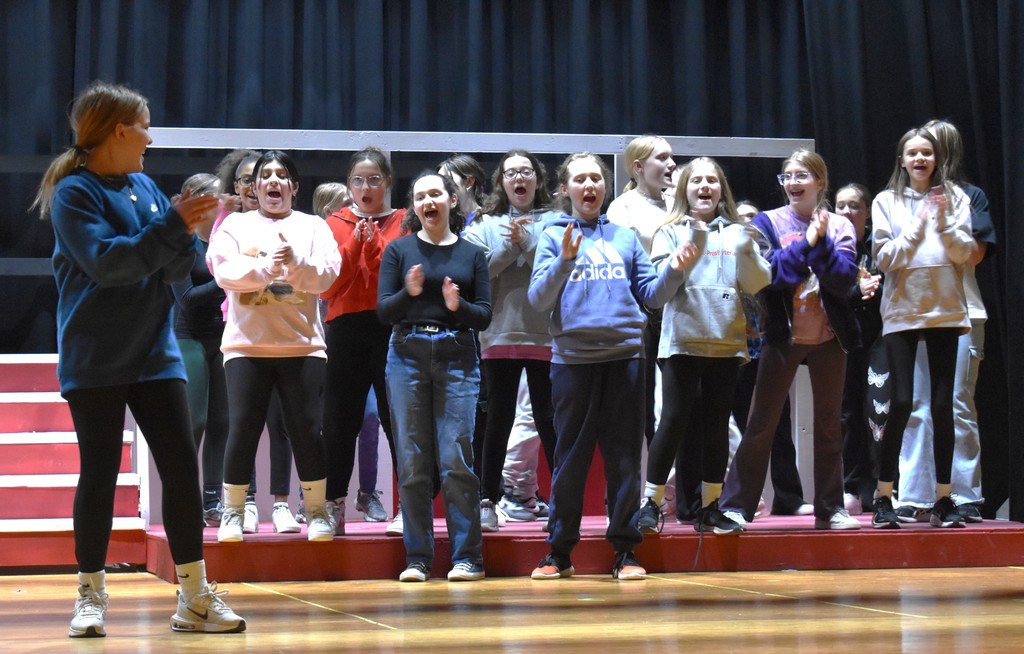

Girls Modified Basketball Coach Kelsie Doller is proud to tell everyone about her teams’ work, passion and drive this season!
“What makes this team truly stand out is their coachability—they’re always ready to learn, improve, and support each other,” she said. “That kind of mentality doesn’t just make great basketball players; it builds strong, determined young women who will go far in whatever they do. I have no doubt that their futures—both on and off the court—are bright.”


lana Kaufman's ES kindergarten art students are taking the seasonality of Valentine's Day and creating Alma Thomas-inspired heart paintings, made with tempera paint!
Alma Thomas was a part of the Washington Color School, a 1950s-1970s art movement in response to Abstract Expressionism. These artists used bold colors to form simple, flat shapes, stripes, and fields of color, rather than focusing on emotion, gesture, and movement. Ms Thomas became an important role model for women, African Americans, and older artists. She was the first African American woman to have a solo exhibition at New York's Whitney Museum of American Art, and she exhibited her paintings at the White House three times.



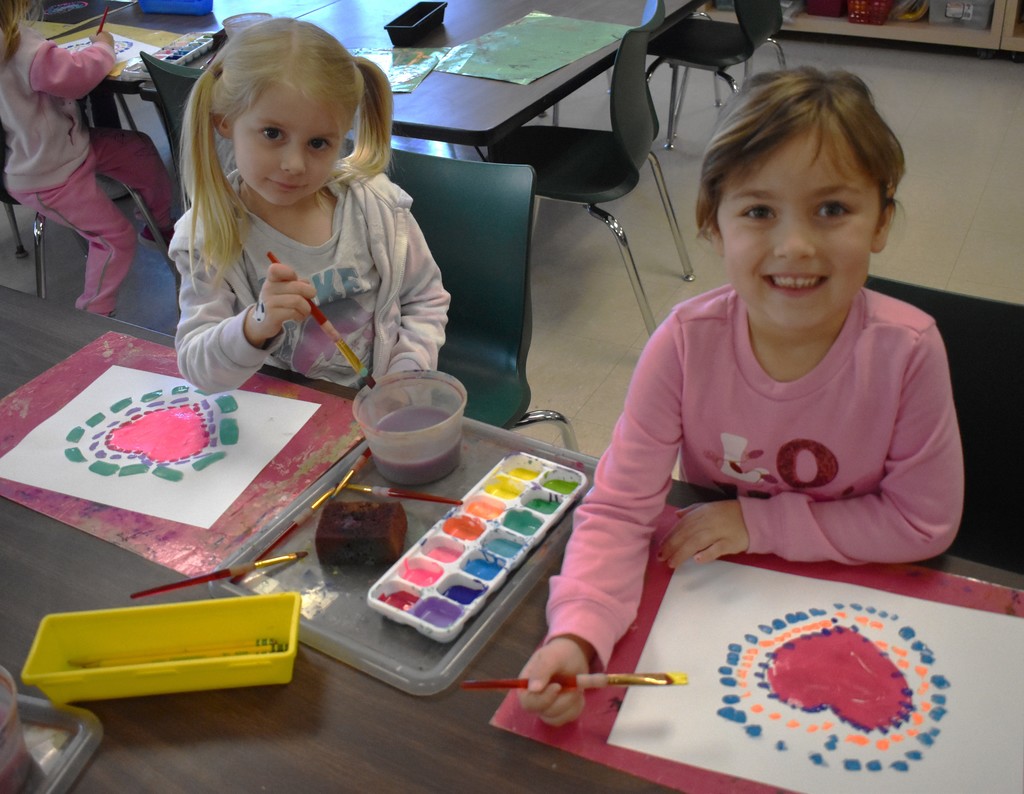


Congratulations to the winners and runners-up of Otisville Elementary’s 2024-25 Yearbook cover/back cover contest!
Fifth graders were invited to draw covers for the yearbook focusing on the school’s theme of "Reach for the Stars" and the results, based on a school vote were:
•Cover: The duo of Liam Card and Nicholas Raponi
•Back cover: Leah Galligan
•Runners-up: JJ Karpinski, Lucas Artola; and the duo of Dejana Rosa and Olivia Bianchi





Otisville physical education teacher Stephanie Giufre has been taking her fourth and fifth-grade students outdoors for snowshoeing fun during their physical education class. They’re getting a great workout!
Snowshoeing is a winter activity that involves walking on snow with the aid of snowshoes, which are a type of footwear that distribute body weight over a larger area, which helps prevent sinking into the snow.
DID YOU KNOW
There are great health benefits to snowshoeing:
•Exceptional cardiovascular workout – you can burn up to 1,000 calories per hour!
•Low-impact muscle building.
•Endurance building.
•Balance strengthening and agility.
•Improves your sense of well-being by connecting to nature






It’s time for volleyball for Anthony Licata’s IS fourth-grade students! They’re not ready to play with a net just yet, as they need to learn the fundamentals of the game first. Take a peek at his students learning how to “bump” the volleyball! They’re picking up this new sport really quickly, too!
The ”bump” is a basic volleyball pass that uses the forearms to move the ball to a teammate or over the net. It's also known as a forearm pass or dig.
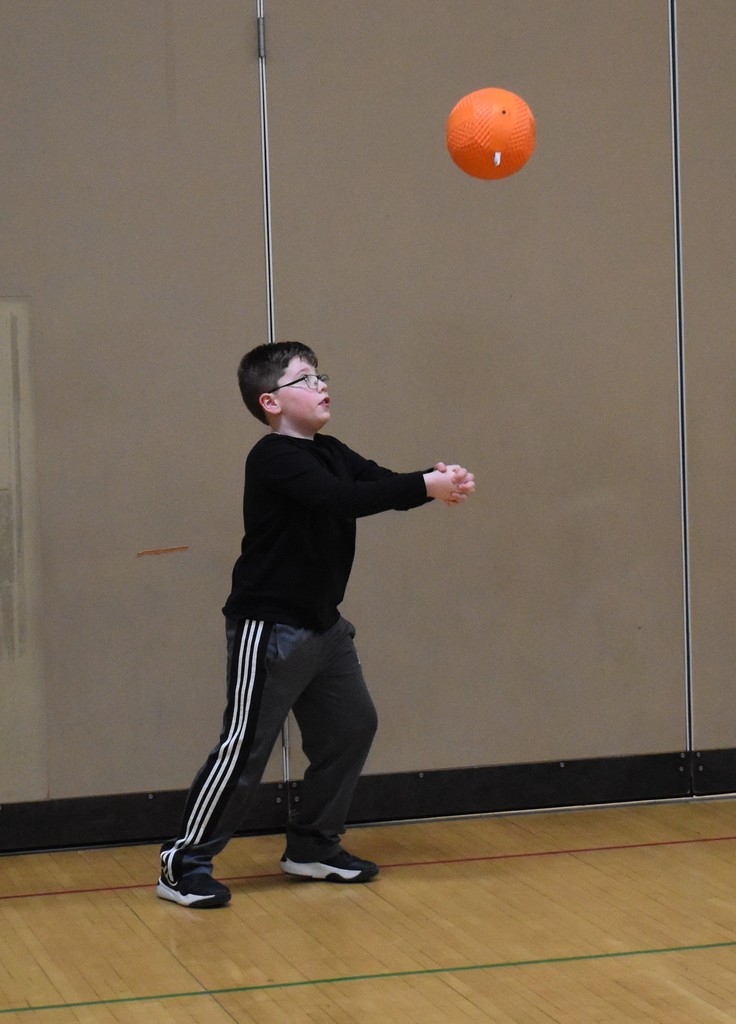
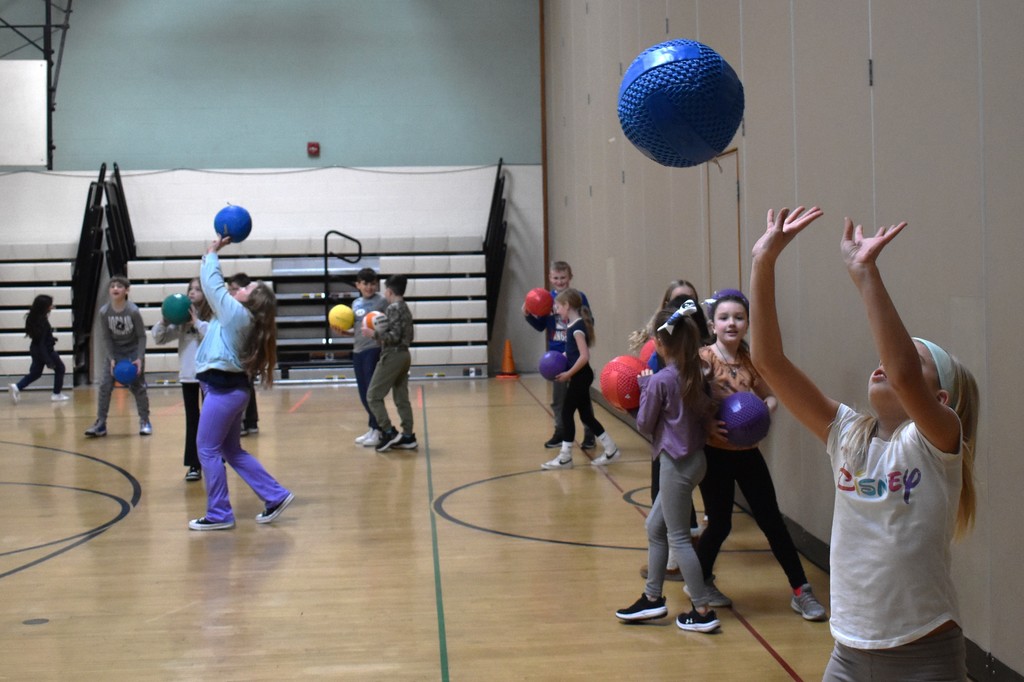



Erin Chase’s ES first-graders are learning about how the Mayans used observatories to look at the sky! As part of their discussion, her little students practiced writing in complete sentences and drew a photo of a Mayan observatory.
The Maya built observatories so that they could examine the nighttime sky to track Earth's journey around the sun, which led to the development of their calendar.
Studying the Maya civilization in first-grade introduces young students to a fascinating ancient culture, exposing them to concepts like different writing systems (hieroglyphics), basic astronomy through their calendar system, and the idea of complex societies with impressive architecture.
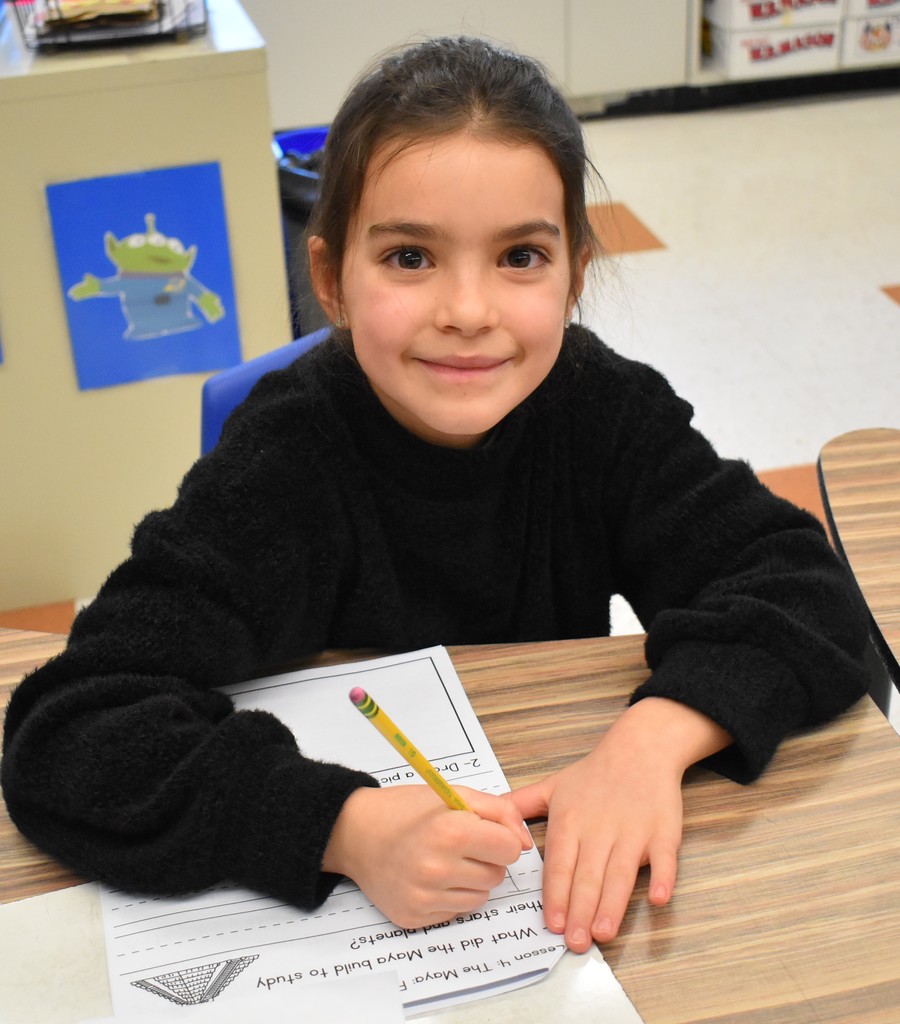

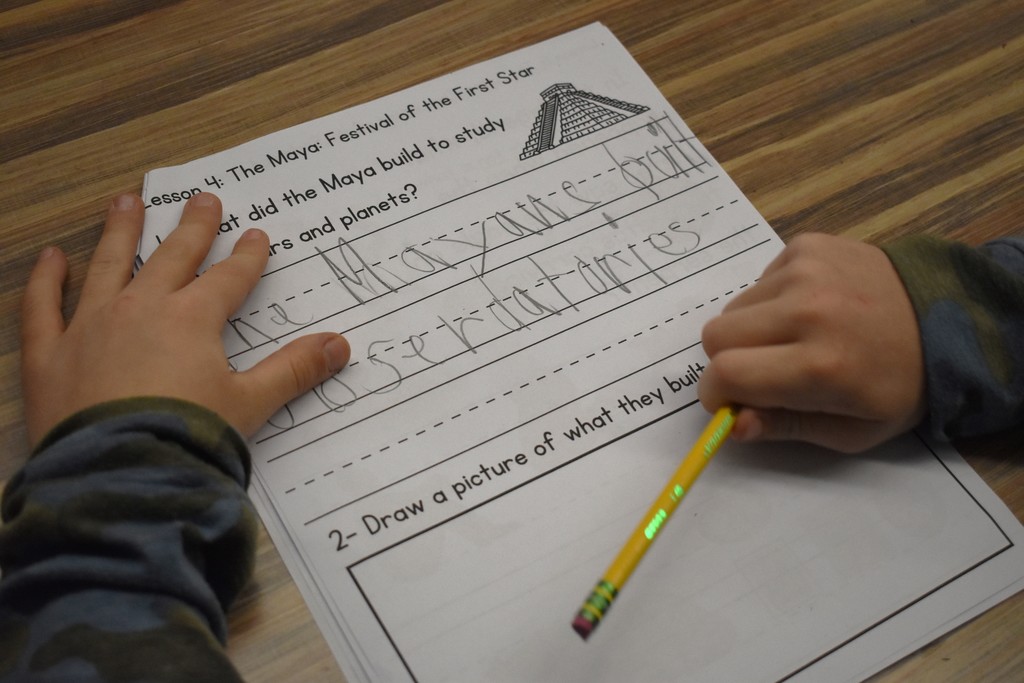
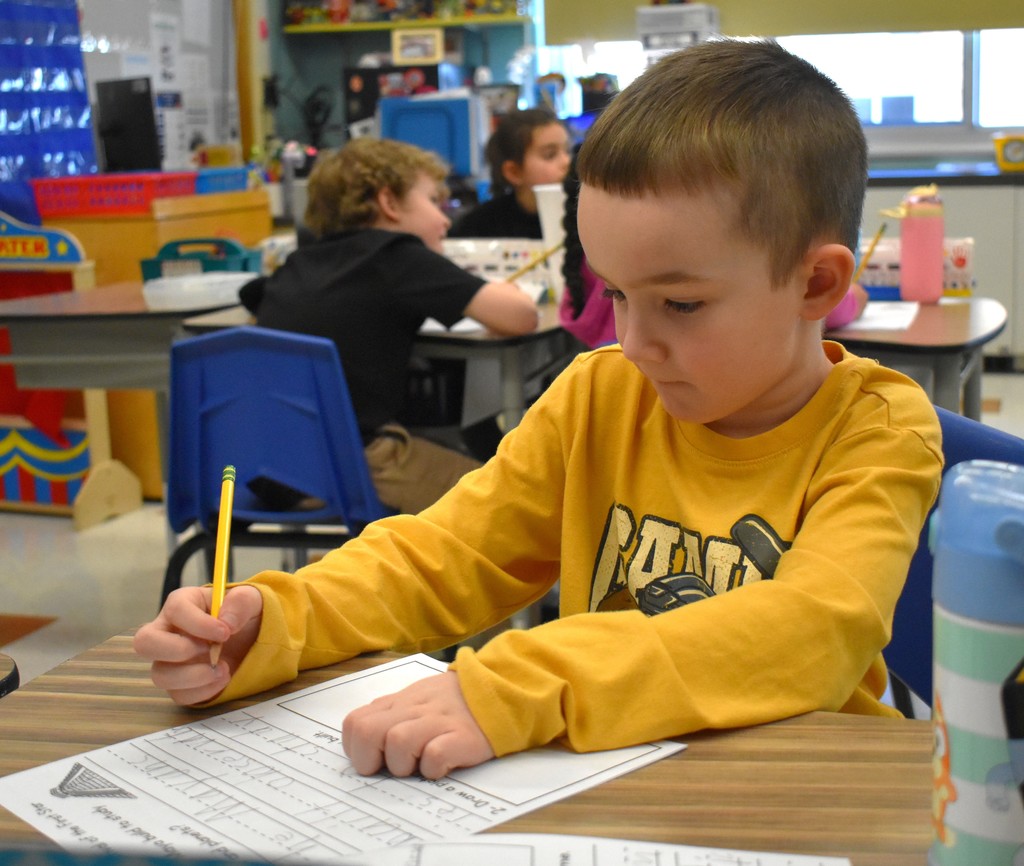
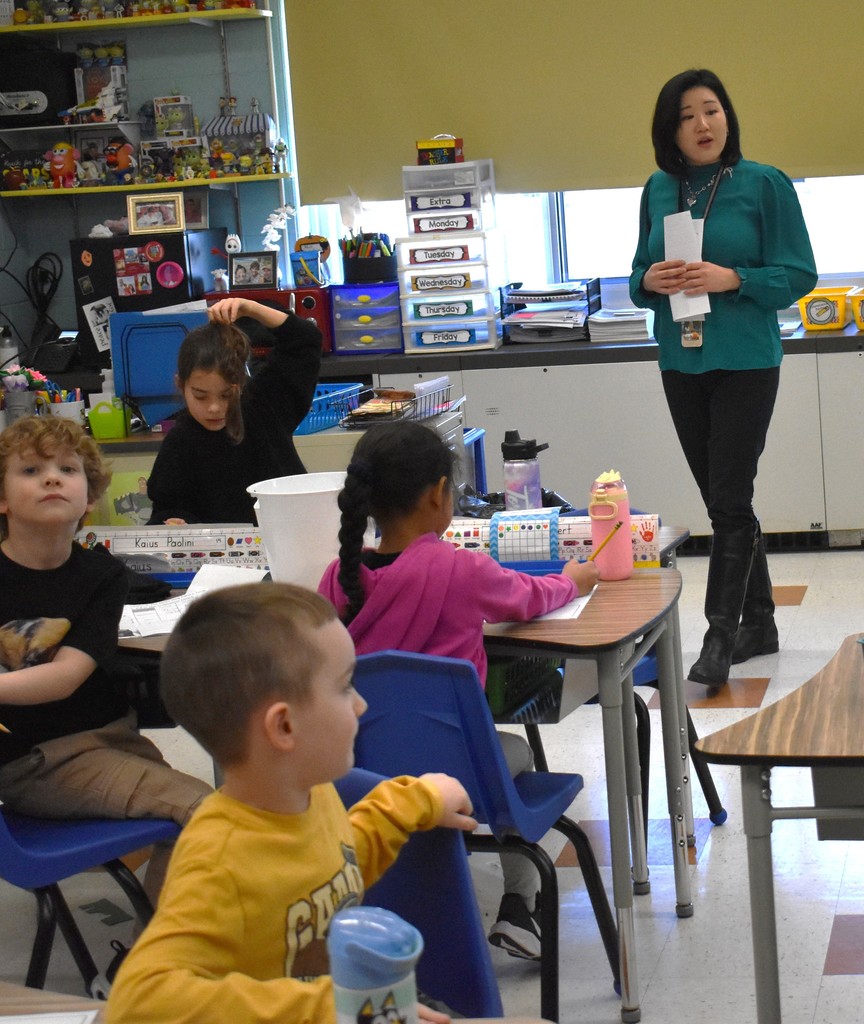
Library classes are always the best --- students can take out books and bring them home to read either solo or with a family member! It’s even better when you can take a book that was read to you in class and then use Play-Doh to create your own animal tracks!
That’s what Mia McLean’s ES kindergarten library students had the chance to do! She read them Mia Posada’s “Who Was Here? Discovering Wild Animal Tracks.” The book focuses on the footprints of wild animals from all around the world. For each animal, there's a rhyming verse, followed by the refrain "Who was here?" along with a life-size footprint on the appropriate terrain.
Afterward, students were given cans of Play-Doh so they could create their animal track of choice! A bear, by far, were the most popular animal track choice, followed by a kangaroo! What a great way of connecting a story with some fine motor skill work! Take a peek at these adorable little students proudly showing off their creations!
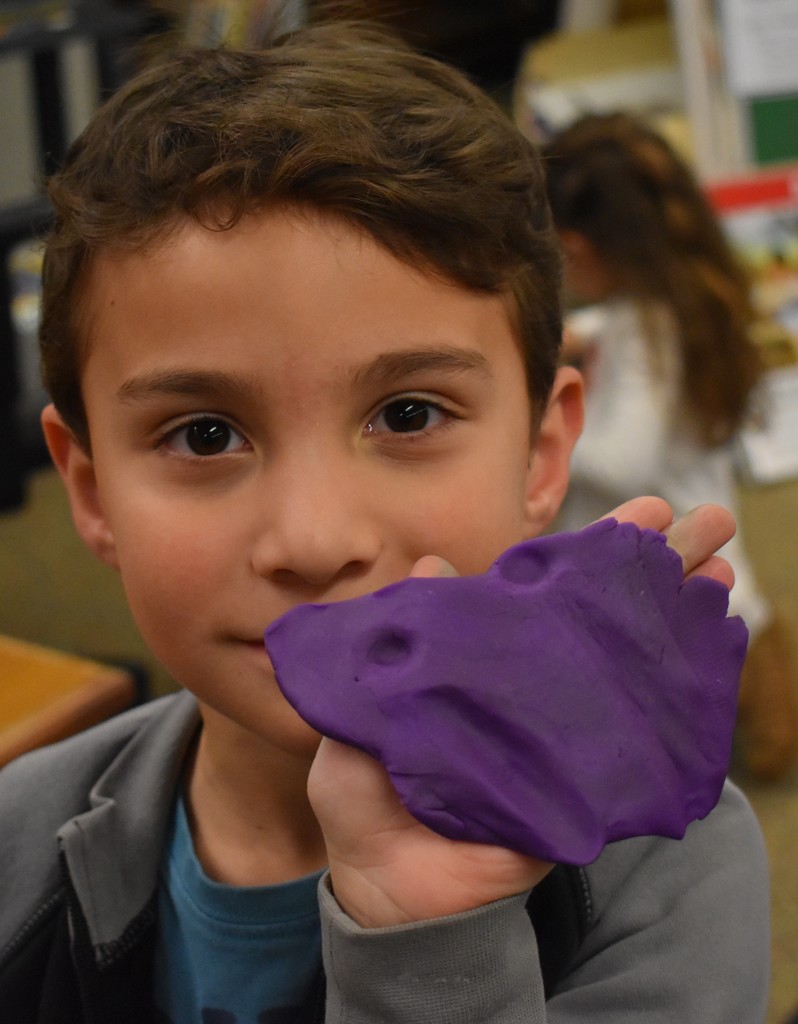





The Intermediate School’s Kindness Ambassadors were recently “on the road” to visit the Elementary School’s students! Every year to wrap up Kindness Week, these ambassadors visit the younger students to present a lesson on kindness followed by an activity.
During their recent visit, the ambassadors presented a recorded read aloud of Trudy Ludwig’s “The Power of One.” Her book tells the story that when one child reaches out in friendship to a classmate who seems lonely, she begins a chain reaction of kindness that ripples throughout her school and her community. One kind act begets another, small good deeds make way for bigger ones, and eventually the whole neighborhood comes together to build something much greater than the sum of its parts.
Their recording was made possible through the kindness of Kat Hoolan’s High School “Media Production” students, who took the ambassadors’ recording and created a more polished video of the book for them to use. 👏👏THANK YOU👏👏 to everyone who played a role in this visit’s success!
DID YOU KNOW
The IS kindness ambassadors are a before-school enrichment program for students who want to spread kindness. Ambassadors are involved in many things throughout the school year, including preparing hygiene kits around the holidays for needy families, creating artwork for the building and serving as liaisons to their classrooms to pass along information regarding the current “Valentines for Veterans” drive as well as sharing information about different holidays.
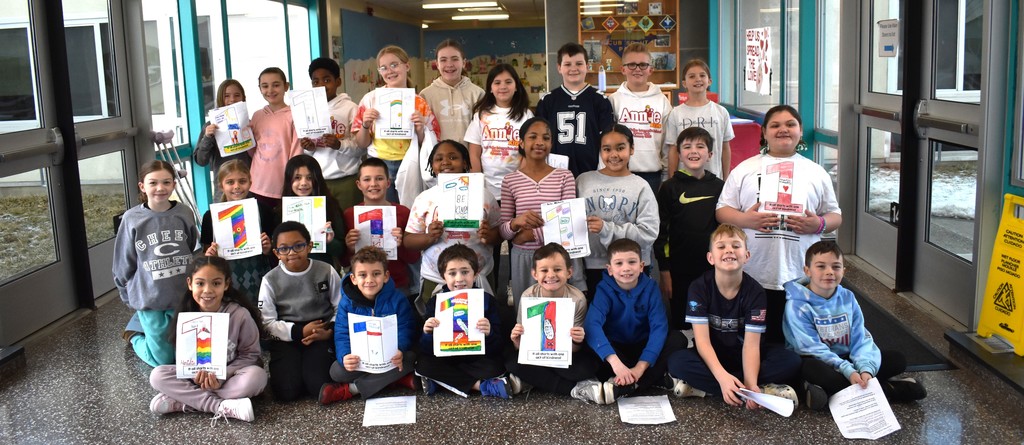
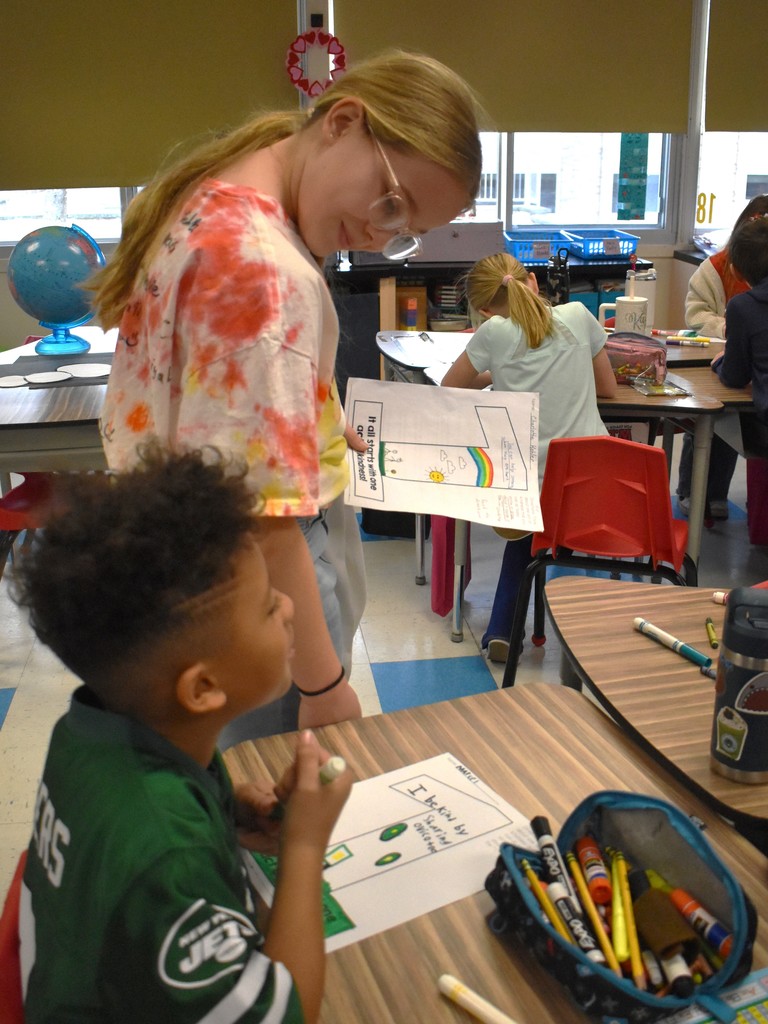

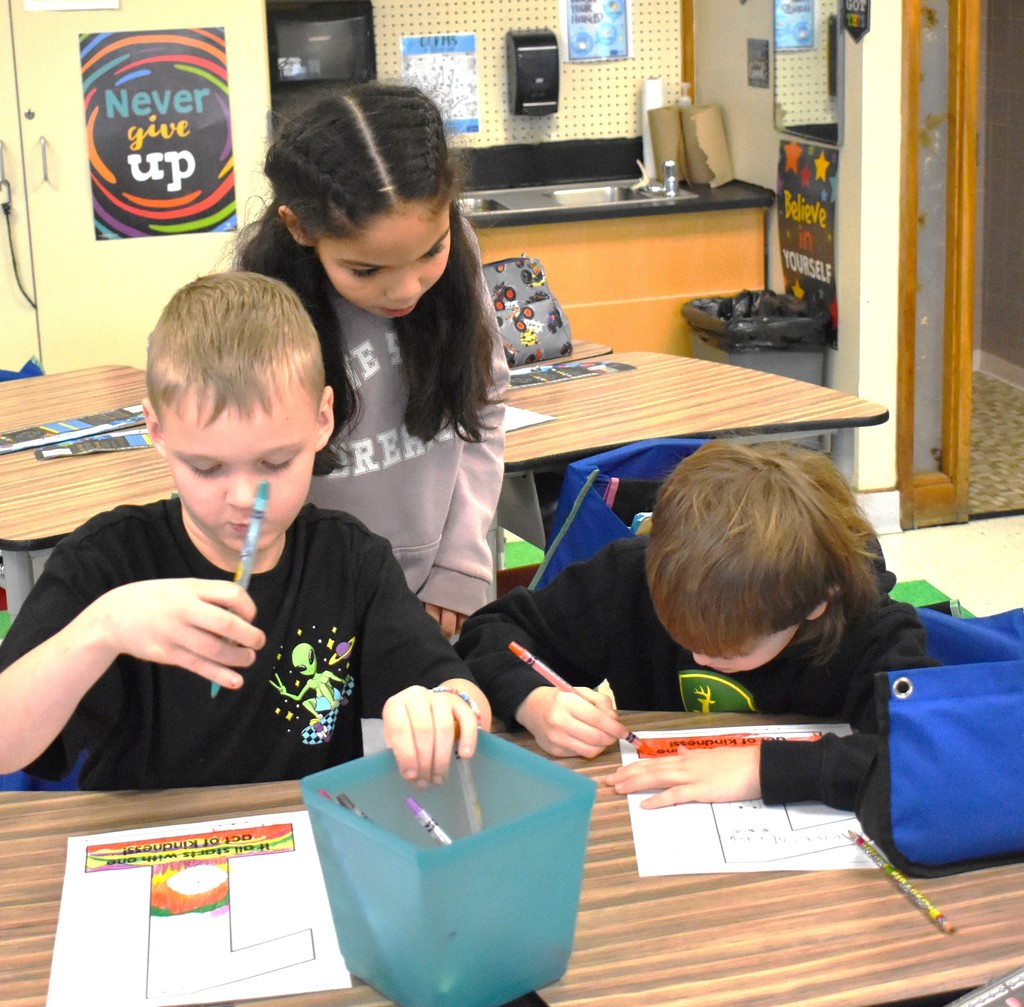
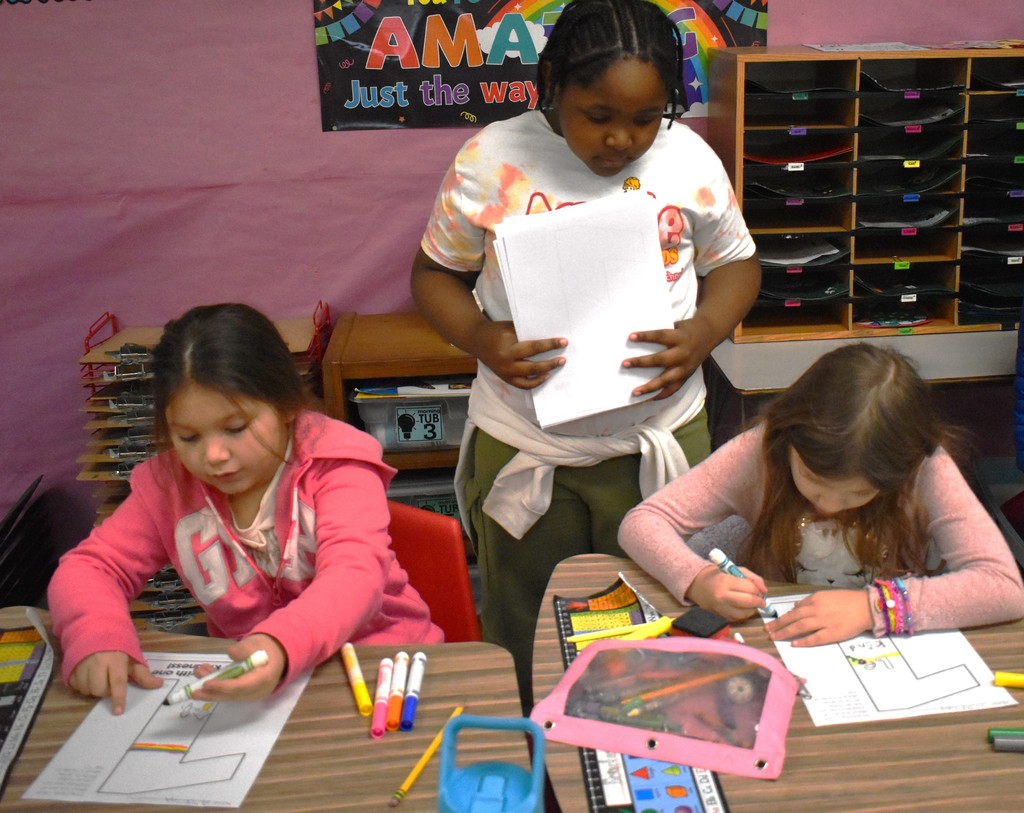


It’s always fun to read a big, oversized book, isn’t it? District kindergarteners, like AnneMarie Guido’s Otisville students, often gather together to do just that!
Mrs. Guido and her students have been reading stories in their CKLA Skills 6 reader called “Kit.” This particular story was called “Kit’s Mom.” (Kit’s mom is really, really, really busy in the morning, by the way!)
In CKLA Skills Unit 6 for kindergarten, a student is expected to be able to read simple decodable texts with CVC (words created using a consonant, vowel and a consonant) words, identify rhyming words, recognize consonant blends, and confidently blend letter sounds to read short words. This is all part of building a strong foundation in phonics skills and having the ability to decode basic text independently, often focusing on high-frequency words and simple sentence structures.
Big books are a crucial component of early childhood literacy curriculum because they allow for interactive shared reading experiences, enabling teachers to explicitly point out and discuss key literacy concepts like print awareness, word boundaries, and vocabulary development with the whole class, all while engaging children with large, easy-to-see text and visuals that support comprehension and participation in the story.
